{"/api/v1/ncpl/currencies/getAll":{"body":[{"Name":"U.S. Dollar","Code":"USD","Symbol":"$","Separator":".","Culture":"en-US"},{"Name":"Euro","Code":"EUR","Symbol":"€","Separator":",","Culture":"en-US"},{"Name":"British Pound","Code":"GBP","Symbol":"£","Separator":".","Culture":"en-US"},{"Name":"Canadian Dollars","Code":"CAD","Symbol":"C$","Separator":".","Culture":"en-US"},{"Name":"Australian Dollars","Code":"AUD","Symbol":"A$","Separator":".","Culture":"en-US"},{"Name":"Indian Rupees","Code":"INR","Symbol":"Rs","Separator":".","Culture":"en-US"},{"Name":"China Yuan RMB","Code":"CNY","Symbol":"¥","Separator":".","Culture":"en-US"}],"status":200,"statusText":"OK"},"/api/v1/ncpl/usermanagement/uiuser/getHeaderUserInfo:\"{\\\"hideSupportPin\\\":true}\"":{"body":{"__ctxId":"2406ED25FC0548DCA7121F205F665945","__isError":true,"__errorType":"Nc.Platform.Abstractions.UnauthorizedException","Http_WWW_Authenticate":"Bearer","StatusCode":"Unauthorized","LogLevel":3,"Message":"","InnerException":null,"HelpLink":null,"Source":"Nc.Security.Middleware"},"status":401,"statusText":"Unauthorized"},"/api/v1/ncpl/cart/user/getShoppingCartSummary:\"{\\\"finalTotalOnly\\\":true}\"":{"body":null,"status":200,"statusText":"OK"}}{"/api/v1/ncpl/simplekb/getarticle:\"{\\\"articleId\\\":9214,\\\"categoryId\\\":31}\"":{"body":{"Id":9214,"FriendlyId":"","ArticleTypeId":2,"Title":"cPanel Email Deliverability Tool – SPF, DKIM, and DMARC Records","ArticleName":"cPanel Email Deliverability Tool – SPF, DKIM, and DMARC Records","ArticleSummary":null,"PreponedSummary":false,"Approved":true,"Body":"QXMgeW91IG1heSBrbm93LCBpZiB0aGUgbWFpbCBzZXJ2aWNlIGlzIHVuYXV0aGVudGljYXRlZCwgeW91IGNhbiBmYWNlIHRoZSBmb2xsb3dpbmcgaXNzdWVzOg0KDQo8YnIgLz48dWw+PGxpPmVtYWlscyB5b3Ugc2VuZCBhcmUgZGVsaXZlcmVkIHRvIFNwYW0vSnVuayBmb2xkZXJzIDxiciAvPjwvbGk+PGxpPmVtYWlscyB5b3Ugc2VuZCBib3VuY2Ugd2l0aCB0aGUgIlNQRiByZWNvcmQgZmFpbHVyZSIgZXJyb3I8L2xpPjxsaT55b3VyIEluYm94IGdldHMgbnVtZXJvdXMgIkZhaWxlZCBkZWxpdmVyeSIgYm91bmNlYmFja3Mgb2YgdGhlIGVtYWlscyB5b3UgbmV2ZXIgc2VudA0KDQo8L2xpPjwvdWw+SW4gdGhlIGZpcnN0IGNhc2UsIHRoZSByZWNpcGllbnQgbWFpbCBzZXJ2ZXIgbG9va3MgdXAgdGhlIFNQRiByZWNvcmQgb2YgeW91ciBkb21haW4sIGFuZCBpZiBpdCBpcyBub3QgYWRkZWQgLyBkb2VzIG5vdCBtYXRjaCB0aGUgYWN0dWFsIG91dGdvaW5nIHNlcnZlciBJUCBhZGRyZXNzLCBzdWNoIG1haWwgZGVsaXZlcnkgd2lsbCBmYWlsLiBUaGlzICBjaGVja2luZyBtZWNoYW5pc20gaXMgaW1wbGVtZW50ZWQgaW4gb3JkZXIgdG8gbWFrZSBzdXJlIGVtYWlsIGNvbWVzIGZyb20gYSBsZWdpdGltYXRlIHNlbmRlciBhbmQgdmVyaWZpZWQgc2VuZGVyLjxiciAvPjxiciAvPjxkaXY+VGhlIHNlY29uZCBzaXR1YXRpb24gdGFrZXMgcGxhY2Ugd2hlbiB0aGVyZSBpcyBubyBTUEYvREtJTSBjb25maWd1cmVkIGZvciB5b3VyIGRvbWFpbiwgb3IgdGhleSBhcmUgY29uZmlndXJlZCBpbmNvcnJlY3RseSwgd2hpY2ggbGV0cyBhbiB1bmF1dGhvcml6ZWQgcGFydHkgZm9yZ2UgZW1haWxzIHVzaW5nIHRoZSBAeW91cmRvbWFpbi5jb20gbWFpbGJveC4gU3VjaCBjYXNlcyBhcmUgY2FsbGVkIDxiPm1haWwgc3Bvb2Zpbmc8L2I+LiA8YnIgLz48L2Rpdj48ZGl2PjxiciAvPjwvZGl2PjxkaXY+PGI+RW1haWwgRGVsaXZlcmFiaWxpdHk8L2I+IGlzIGFuIGVmZmVjdGl2ZSBzZXQgb2YgYW50aS1zcG9vZmluZyBhbmQgYW50aS1zcGFtbWluZyB0b29scyBhdmFpbGFibGUgaW4gY1BhbmVsLiA8YnIgLz48L2Rpdj48ZGl2PjxiciAvPjwvZGl2PjxkaXY+PGRpdj5UaGUgPGI+RW1haWwgRGVsaXZlcmFiaWxpdHkgPC9iPnRhYmxlIGRpc3BsYXlzIHlvdXIgY1BhbmVsIA0KYWNjb3VudCBkb21haW5zIGFuZCBhbGxvd3MgeW91IHRvIGFkZHJlc3MgYW55IGV4aXN0aW5nIHByb2JsZW1zIHdpdGggDQp5b3VyIG1haWwtcmVsYXRlZCBETlMgcmVjb3JkcyDigJMgPGI+PGEgaHJlZj0iI3NwZiI+U1BGPC9hPjwvYj4sIDxiPjxhIGhyZWY9IiNka2ltIj5ES0lNPC9hPjwvYj4gYW5kIDxiPjxhIGhyZWY9IiNkbWFyYyI+RE1BUkM8L2E+PC9iPi4gPGJyIC8+PC9kaXY+PGRpdj48YnIgLz48L2Rpdj48ZGl2Pjx1bD48bGk+PGI+PGEgbmFtZT0ic3BmIj5TUEY8L2E+PC9iPjwvbGk+PC91bD5Ob3dhZGF5cywgdGhlIHZhc3QgbWFqb3JpdHkgb2Ygc3BhbSBlbWFpbHMgaGF2ZSANCmZha2UgZGF0YSBpbiB0aGUgwqtGcm9twrsgZmllbGQuIFNwYW1tZXJzIGFuZCBmcmF1ZHN0ZXJzIHVzZSBzcGVjaWFsIHRvb2xzDQogdG8gc2VuZCB0aGVpciBtYWlsIG9uIGJlaGFsZiBvZiBhIHJlYWwgb3duZXIgb2YgdGhlIGVtYWlsIGFkZHJlc3MuDQoNCg0KCQkJCTwvZGl2PjxkaXY+PGJyIC8+PC9kaXY+PGRpdj48Yj5TUEY8L2I+IHJlY29yZCAoYW4gYWNyb255bSBmb3IgU2VuZGVyIFBvbGljeSBGcmFtZXdvcmspIGlzIGFuIGVmZmVjdGl2ZSANCmFuZCBzaW1wbGUgbWV0aG9kIHRoYXQgYWxsb3dzIHlvdSB0byBhdm9pZCBzdWNoIGlzc3Vlcy4gSWYgeW91ciBkb21haW4gbmFtZSANCmhhcyB0aGUgY29ycmVjdCBTUEYgcmVjb3JkLCB0aGVuIHlvdSBjYW4gYmUgc3VyZSBub2JvZHkgY2FuIHNlbmQgZmFrZSANCmVtYWlscyBvbiBiZWhhbGYgb2YgeW91ciBkb21haW4gbmFtZS4NCg0KPGJyIC8+PGJyIC8+VGhlIG1haW4gaWRlYSBvZiB0aGUgU1BGIHJlY29yZCBpcyB0aGF0IGFuIG93bmVyIG9mIGEgZG9tYWluIG5hbWUgDQpwdWJsaXNoZXMgdGhlIGluZm9ybWF0aW9uIGFib3V0IElQIGFkZHJlc3NlcyB0aGF0IGFyZSBhdXRob3JpemVkIHRvIHNlbmQNCiBtYWlsIGZyb20gdGhpcyBkb21haW4gbmFtZS4gVGhlIHJlY2VpdmluZyBzZXJ2ZXIgY29tcGFyZXMgdGhlIA0KaW5mb3JtYXRpb24gaW4gdGhlIGVudmVsb3BlIHNlbmRlciBhZGRyZXNzIHdpdGggdGhlIGluZm9ybWF0aW9uIA0KcHVibGlzaGVkIGJ5IHRoZSBkb21haW4gbmFtZSBvd25lci4gSWYgdGhlc2UgZGV0YWlscyBtYXRjaCwgdGhlbiB0aGUgZW1haWwgaXMgDQpkZWxpdmVyZWQuDQoNCg0KPGJyIC8+PGJyIC8+PGI+Tk9URVM6PC9iPjxiciAvPjwvZGl2PjxkaXY+PHVsPjxsaT5TUEYgaXMgbm90IGFkZGVkIHRvIHRoZSBkb21haW4gRE5TIHpvbmUgYXV0b21hdGljYWxseS4gVGh1cywgaXQgaXMgcmVxdWlyZWQgdG8gY29uZmlndXJlIHRoZSBwcm9wZXIgcmVjb3JkIGZyb20gdGhlIDxiPkVtYWlsIERlbGl2ZXJhYmlsaXR5IDwvYj5tZW51LiA8L2xpPjxsaT5Tb21ldGltZXMsIGNQYW5lbCBhdXRvbWF0aWNhbGx5IGZldGNoZXMgaW5jb3JyZWN0IA0Kc2VydmVyIG91dGdvaW5nIElQIGFkZHJlc3Nlcy4gVGhpcyBoYXBwZW5zIHdoZW4gd2UgaGF2ZSB0byBjaGFuZ2UgYW4gb3V0Z29pbmcNCiBtYWlsIElQIGR1ZSB0byBwb29yIG1haWwgcmVwdXRhdGlvbiBvciBibGFja2xpc3RzLiBHZXQgaW4gdG91Y2ggd2l0aCB1cyB2aWEgPGEgaHJlZj0iaHR0cHM6Ly93d3cubmFtZWNoZWFwLmNvbS9zdXBwb3J0L2xpdmUtY2hhdC9nZW5lcmFsLmFzcHgiPkxpdmUgQ2hhdDwvYT4gb3IgPGEgaHJlZj0iaHR0cHM6Ly93d3cubmFtZWNoZWFwLmNvbS9zdXBwb3J0L2tub3dsZWRnZWJhc2UvYXJ0aWNsZS5hc3B4LzIyNy81L2hvdy1jYW4taS1yZXF1ZXN0LXN1cHBvcnQtdmlhLWVtYWlsLyI+ZW1haWw8L2E+LCBhbmQgd2Ugd2lsbCBnbGFkbHkgcmUtY2hlY2sgaWYgdGhlIGNvcnJlY3QgSVAgaXMgYWRkZWQgdG8geW91ciBTUEYgcmVjb3JkLjwvbGk+PGxpPlNQRiByZWNvcmQgaGFzIGl0cyBvd24gc3BlY2lmaWMgc3ludGF4LiBJdCBpcyBzdHJvbmdseSByZWNvbW1lbmRlZCB0aGF0IHlvdSBnZXQgZmFtaWxpYXIgd2l0aCA8YSBocmVmPSJodHRwczovL3d3dy5zcGYtcmVjb3JkLmNvbS9zeW50YXgiIGxpbmt0ZXh0PSJTUEYgcmVjb3JkIHN5bnRheCBkb2N1bWVudGF0aW9uIiBsaW5rdHlwZT0iQ3VzdG9tIiB0YXJnZXQ9Il9wYXJlbnQiPlNQRiByZWNvcmQgc3ludGF4IGRvY3VtZW50YXRpb248L2E+IGlmIHlvdSBhcmUgZ29pbmcgdG8gY3VzdG9taXplIHRoZSByZWNvcmQgbWFudWFsbHkuwqA8L2xpPjxsaT5TUEYgcmVjb3JkIGlzIGFkZGVkIHRvIHlvdXIgZG9tYWluIEROUyB6b25lIGFzIA0KYSBUWFQgcmVjb3JkLiBUaGVyZSBhcmUgY2FzZXMgd2hlbiB5b3UgbmVlZCB0byBhZGQgYW5vdGhlciBUWFQgcmVjb3JkIHRvIA0KdmVyaWZ5IHlvdXIgZG9tYWluIG5hbWUgb3duZXJzaGlwIGZvciBzb21lIHNlcnZpY2UuIEl0IGlzIG5vdCANCnJlY29tbWVuZGVkIHRoYXQgeW91IG1vZGlmeSB0aGUgZXhpc3RpbmcgU1BGIHJlY29yZDsgaXQgaXMgYmV0dGVyIHRvIGFkZCBhIG5ldyBvbmUNCiBpbnN0ZWFkLiA8YnIgLz48YnIgLz48L2xpPjwvdWw+PC9kaXY+PGRpdj48dWw+PGxpPjxiPjxhIG5hbWU9ImRraW0iPkRLSU08L2E+PC9iPjwvbGk+PC91bD48Yj5ES0lNPC9iPiAoRG9tYWluS2V5cyBJZGVudGlmaWVkDQogTWFpbCkgaXMgYW5vdGhlciB3YXkgb2YgZW1haWwgYXV0aGVudGljYXRpb24uIFRoaXMgbWV0aG9kIHVzZXMgDQppbmZvcm1hdGlvbiBhYm91dCB0aGUgZG9tYWluIHdoaWNoIGlzIHB1Ymxpc2hlZCBieSB0aGUgZG9tYWluIG93bmVyLiBUaGF0IA0KaW5mb3JtYXRpb24gYWxsb3dzIHRoZSByZWNlaXZpbmcgc2VydmVyIHRvIHZlcmlmeSBpZiB0aGUgZW1haWwgbWVzc2FnZSB3YXMgDQpzZW50IGJ5IHRoZSBsZWdhbCBvd25lciBvZiB0aGF0IGRvbWFpbiBuYW1lLiANCg0KPGJyIC8+PGJyIC8+T25jZSB0aGUgVFhUIHJlY29yZCwgd2hpY2ggY29udGFpbnMgREtJTSwgaXMgYWRkZWQgdG8gdGhlIEROUyB6b25lLCBhDQogc3BlY2lhbCBjb2RlIGlzIGFkZGVkIHRvIHRoZSBoZWFkZXJzIG9mIG91dGdvaW5nIGVtYWlscy4gUmVjZWl2aW5nIA0Kc2VydmVycyBjb21wYXJlIHRoZXNlIGhlYWRlcnMgd2l0aCB0aGUgaW5mb3JtYXRpb24gaW4gdGhlIEROUyB6b25lLCBhbmQgaWYgaXQNCiBtYXRjaGVzLCB0aGVuIHRoZSBlbWFpbCBpcyBkZWxpdmVyZWQuDQoNCjxiciAvPjxiciAvPjxiPk5PVEU6IDwvYj5Eb21haW5LZXlzKERLKSBhbmQgRG9tYWluS2V5cyBJZGVudGlmaWVkIE1haWwgKERLSU0pIGFyZSBzZXBhcmF0ZSB0aGluZ3MuDQoNCjxiciAvPjxiciAvPkRvbWFpbktleXMoREspIGFyZSBub3QgYXZhaWxhYmxlIG9uIG91ciBzaGFyZWQgc2VydmVycyBhcyBESyANCmltcGxlbWVudGF0aW9uIHdhcyBjb252ZXJ0ZWQgdG8gREtJTSBhbmQgZXh0ZW5kZWQgaW4gYSBudW1iZXIgb2Ygd2F5cyBhcw0KIG9mIGNQYW5lbCAxMS4zMiBhbmQgbGF0ZXIgcmVsZWFzZXMuDQoNCjxiciAvPjxiciAvPlNvbWUgb2YgdGhlIGRpZmZlcmVuY2VzIGJldHdlZW4gRG9tYWluS2V5cyBhbmQgREtJTSBpbmNsdWRlOg0KDQo8YnIgLz48dWw+PGxpPm11bHRpcGxlIHNpZ25hdHVyZSBhbGdvcml0aG1zIChhcyBvcHBvc2VkIHRvIGp1c3Qgb25lIGF2YWlsYWJsZSB3aXRoIERvbWFpbktleXMpOzwvbGk+PGxpPm1vcmUgb3B0aW9ucyB3aXRoIHJlZ2FyZCB0byBjYW5vbmljYWxpemF0aW9uLCB0aGF0IHZhbGlkYXRlcyB0aGUgaGVhZGVyIGFuZCBib2R5OzwvbGk+PGxpPnRoZSBhYmlsaXR5IHRvIGRlbGVnYXRlIHNpZ25pbmcgdG8gdGhpcmQgcGFydGllczs8L2xpPjxsaT50aGUgYWJpbGl0eSBmb3IgREtJTSB0byBzZWxmLXNpZ24gdGhlIERLSU0tU2lnbmF0dXJlIGhlYWRlciBmaWVsZCDigJMgdG8gcHJvdGVjdCBhZ2FpbnN0IGl0cyBiZWluZyBtb2RpZmllZDs8L2xpPjxsaT50aGUgYWJpbGl0eSBmb3IgdGhlIHdpbGRjYXJkIG9wdGlvbiBvbiBzb21lIHBhcmFtZXRlcnM7PC9saT48bGk+dGhlIGFiaWxpdHkgdG8gc3VwcG9ydCA8YSBocmVmPSJodHRwOi8vc3RhY2tvdmVyZmxvdy5jb20vcXVlc3Rpb25zLzU1ODAxMzYvZGlmZmVyZW5jZXMtYmV0d2Vlbi1kb21haW5rZXlzLXZzLWRraW0iPnNpZ25hdHVyZSB0aW1lb3V0cyBpbiBETlMuPC9hPjxiciAvPjwvbGk+PC91bD5JZg0KIGhhdmluZyBEb21haW5LZXlzIGZvciB5b3UgaXMgYSBtdXN0LCB3ZSBzdWdnZXN0IHVwZ3JhZGluZyB0byANCmEgVlBTL0RlZGljYXRlZCBzZXJ2ZXIsIHdoZXJlIHlvdSB3aWxsIGJlIGFibGUgdG8gc2V0IHVwIHRoaXMgZmVhdHVyZS4NCg0KPGJyIC8+PGJyIC8+VGhlc2Ugc2ltcGxlIGFjdGlvbnMgd2lsbCBtYWtlIHlvdSBzdXJlIHRoYXQgbm8gb25lIGNhbg0KIHNlbmQgc3BhbSBvbiB5b3VyIGJlaGFsZiBhbmQgeW91ciBlbWFpbCB3aWxsIG5vdCBiZSBkZWxpdmVyZWQgdG8gc3BhbSANCmZvbGRlcnMuDQo8ZGl2PlRvIGNvbmZpZ3VyZSB0aGUgU1BGIGFuZCBES0lNIHJlY29yZHMsIGxvZyBpbiB0byAgPGI+Y1BhbmVsPC9iPiAmZ3Q7IHRoZSA8Yj5FbWFpbDwvYj4gc2VjdGlvbiAmZ3Q7IHRoZSA8Yj5FbWFpbCBEZWxpdmVyYWJpbGl0eTwvYj4gbWVudTo8YnIgLz48YnIgLz48aW1nIGNsYXNzPSJrYi1pbWFnZSIgc3JjPSJodHRwczovL05hbWVjaGVhcC5zaW1wbGVrYi5jb20vU2l0ZUNvbnRlbnRzLzItN0MyMkQ1MjM2QTQ1NDNFQjgyN0YzQkQ4OTM2RTE1M0UvbWVkaWEvZGVsaXZlcmFiaWxpdHkxLnBuZyIgLz48YnIgLz48YnIgLz48L2Rpdj5UaGlzIHNlY3Rpb24gYWxsb3dzIHlvdSB0byBwZXJmb3JtIHRoZSBmb2xsb3dpbmcgYWN0aW9uczo8ZGl2PjxiciAvPjwvZGl2PjxkaXY+MS48Yj4gUmVwYWlyPC9iPiDigJQgdGhpcyBmZWF0dXJlIGFsbG93cyB0aGUgc3lzdGVtIHRvIHJlcGFpciBkb21haW4gaW52YWxpZCByZWNvcmRzOjwvZGl2PjxkaXY+PGJyIC8+PC9kaXY+PGRpdj48Yj5OT1RFUzwvYj46PC9kaXY+PGRpdj48dWw+PGxpPlRoaXMgb3B0aW9uIGlzIHVuYXZhaWxhYmxlIGlmIHRoZSBzeXN0ZW0gZG9lcyBub3QgY29udHJvbCB0aGUgZG9tYWluIEROUyByZWNvcmRzLiBUaHVzLCB5b3Ugd2lsbCBiZSBhYmxlIHRvIHVzZSB0aGUgUmVwYWlyIG9wdGlvbiBvbmx5IGluIGNhc2UgeW91ciBkb21haW4gbmFtZSBpcyBwb2ludGVkIHRvIG91ciA8Yj5TaGFyZWQgaG9zdGluZyBuYW1lc2VydmVyczwvYj4uPC9saT48bGk+WW91IGNhbm5vdCBzaW11bHRhbmVvdXNseSB1cGRhdGUgdHdvIG9yIG1vcmUgZG9tYWlucyB3aG9zZSByZWNvcmRzIGV4aXN0IGluIHRoZSBzYW1lIHpvbmUuIFRoZSBidWxrIHJlY29yZHMgdXBkYXRlIGlzIHBvc3NpYmxlIG9ubHkgaW4gY2FzZSBkb21haW4gcmVjb3JkcyBleGlzdCBpbiBzZXBhcmF0ZSB6b25lcy48L2xpPjxsaT5SZWxvYWRpbmcgdGhlIGludGVyZmFjZSBkb2VzIG5vdCBpbnRlcnJ1cHQgdGhlIHJlcGFpciBwcm9jZXNzLjxiciAvPjwvbGk+PC91bD48YnIgLz48aW1nIGNsYXNzPSJrYi1pbWFnZSIgc3JjPSJodHRwczovL05hbWVjaGVhcC5zaW1wbGVrYi5jb20vU2l0ZUNvbnRlbnRzLzItN0MyMkQ1MjM2QTQ1NDNFQjgyN0YzQkQ4OTM2RTE1M0UvbWVkaWEvZW1haWwgZGVsaXZlcmFiaWxpdHlfMS5wbmciIC8+PGJyIC8+PGJyIC8+IEluIHRoZSB3aW5kb3cgdGhhdCBhcHBlYXJzIHVwb24gY2xpY2tpbmcgPGI+UmVwYWlyPC9iPiwgeW91IGNhbiByZXZpZXcgYW5kIGNvbmZpcm0gdGhlIHN5c3RlbSByZWNvbW1lbmRhdGlvbnMgZm9yIGFueSBpbnZhbGlkIHJlY29yZHMuIFlvdSBjYW4gYWxzbyA8Yj5Db3B5PC9iPiBvciA8Yj5DdXN0b21pemU8L2I+IGEgc3VnZ2VzdGVkIHJlY29yZCBiZWZvcmUgeW91IGFwcHJvdmUgdGhlIHN5c3RlbSByZXBhaXJzLiBDbGljayBvbiA8Yj5SZXBhaXI8L2I+LCBhbmQgdGhlIHJlY29yZHMgd2lsbCBiZSBhZGRlZCB0byB0aGUgRE5TIHpvbmUgb2YgdGhlIGRvbWFpbi9zdWJkb21haW4gYXV0b21hdGljYWxseTo8YnIgLz48YnIgLz48aW1nIGNsYXNzPSJrYi1pbWFnZSIgc3JjPSJodHRwczovL05hbWVjaGVhcC5zaW1wbGVrYi5jb20vU2l0ZUNvbnRlbnRzLzItN0MyMkQ1MjM2QTQ1NDNFQjgyN0YzQkQ4OTM2RTE1M0UvbWVkaWEvcmVwYWlyX29wdGlvbjIucG5nIiAvPjxiciAvPjxiciAvPlRoaXMgcHJvY2VzcyBjYW4gdGFrZSB1cCB0byA8Yj5maXZlIG1pbnV0ZXM8L2I+LCBkZXBlbmRpbmcgb24gdGhlIHNlcnZlci4gV2hlbiB0aGUgcmVjb3JkcyBhcmUgc2V0IHVwLCB5b3Ugd2lsbCByZWNlaXZlIGEgY29ycmVzcG9uZGluZyBzdWNjZXNzIG1lc3NhZ2U6PGJyIC8+PGJyIC8+PGltZyBjbGFzcz0ia2ItaW1hZ2UiIHNyYz0iaHR0cHM6Ly9OYW1lY2hlYXAuc2ltcGxla2IuY29tL1NpdGVDb250ZW50cy8yLTdDMjJENTIzNkE0NTQzRUI4MjdGM0JEODkzNkUxNTNFL21lZGlhL3JlcGFpcl9vcHRpb24zLnBuZyIgLz48YnIgLz48YnIgLz5BbGxvdyBzb21lIHRpbWUgZm9yIHRoZSByZWNvcmRzIHRvIHByb3BhZ2F0ZSBhbmQgcmVmcmVzaCB0aGUgcGFnZSBhZnRlcndhcmRzLg0KVGhlIDxiPkVtYWlsIERlbGl2ZXJhYmlsaXR5IFN0YXR1cyA8L2I+d2lsbCBiZSB0aGVuIGNoYW5nZWQgdG8gPGI+VmFsaWQ8L2I+OjxiciAvPjxiciAvPjxpbWcgY2xhc3M9ImtiLWltYWdlIiBzcmM9Imh0dHBzOi8vTmFtZWNoZWFwLnNpbXBsZWtiLmNvbS9TaXRlQ29udGVudHMvMi03QzIyRDUyMzZBNDU0M0VCODI3RjNCRDg5MzZFMTUzRS9tZWRpYS9yZXBhaXJfb3B0aW9uNC5wbmciIC8+PGJyIC8+PGJyIC8+Mi4gPGI+TWFuYWdlPC9iPiAtIHRoaXMgb3B0aW9uIGFsbG93cyB5b3UgdG8gbWFudWFsbHkgY29uZmlndXJlIHRoZSBtYWlsLXJlbGF0ZWQgRE5TIHJlY29yZHMgb2YgYSBkb21haW4uIDxiciAvPjwvZGl2PjxkaXY+PGJyIC8+PC9kaXY+PGRpdj5UaGUgPGI+TWFuYWdlIHRoZSBEb21haW48L2I+IHNlY3Rpb24gYWxyZWFkeSBkaXNwbGF5cyB0aGUgcHJvcGVybHktY29uZmlndXJlZCBES0lNLCBTUEYgYW5kIERNQVJDIHJlY29yZCB2YWx1ZXMuIFNvIGluIG1vc3QgY2FzZXMsIHlvdSBqdXN0IG5lZWQgdG8gPGI+Q29weTwvYj4gdGhlbSBhbmQgcGFzdGUgbWFudWFsbHkgdG8gdGhlIEROUyB6b25lIG9mIHlvdXIgZG9tYWluLiBBbHRlcm5hdGl2ZWx5LCB5b3UgY2FuIGNsaWNrIDxiPkluc3RhbGwgdGhlIHN1Z2dlc3RlZCByZWNvcmQ8L2I+IHRvIGhhdmUgdGhlIHJlY29yZHMgYWRkZWQgdG8gdGhlIEROUyB6b25lIGF1dG9tYXRpY2FsbHk6PC9kaXY+PGRpdj48YnIgLz48L2Rpdj48ZGl2PjxiPk5PVEU8L2I+OiBUaGU8Yj4gSW5zdGFsbCB0aGUgc3VnZ2VzdGVkIHJlY29yZDwvYj4gb3B0aW9uIGlzIGF2YWlsYWJsZSBvbmx5IGluIGNhc2UgeW91ciBkb21haW4gbmFtZSBpcyBwb2ludGVkIHRvIG91ciA8Yj5TaGFyZWQgaG9zdGluZyBuYW1lc2VydmVyczwvYj4uPGJyIC8+PGJyIC8+PGltZyBjbGFzcz0ia2ItaW1hZ2UiIHNyYz0iaHR0cHM6Ly9OYW1lY2hlYXAuc2ltcGxla2IuY29tL1NpdGVDb250ZW50cy8yLTdDMjJENTIzNkE0NTQzRUI4MjdGM0JEODkzNkUxNTNFL21lZGlhL21hbmFnZV9vcHRpb24xLnBuZyIgLz48YnIgLz48YnIgLz5BZnRlciB0aGUgcmVjb3JkIGlzIGluc3RhbGxlZCwgeW91IHdpbGwgcmVjZWl2ZSB0aGUgY29uZmlybWF0aW9uIG1lc3NhZ2U6PGJyIC8+PGJyIC8+PGltZyBjbGFzcz0ia2ItaW1hZ2UiIHNyYz0iaHR0cHM6Ly9OYW1lY2hlYXAuc2ltcGxla2IuY29tL1NpdGVDb250ZW50cy8yLTdDMjJENTIzNkE0NTQzRUI4MjdGM0JEODkzNkUxNTNFL21lZGlhL21hbmFnZV9vcHRpb24xci5wbmciIC8+PGRpdj48YnIgLz48YnIgLz5JbiB0aGUgPGI+U1BGPC9iPiBzZWN0aW9uLCB5b3Ugd2lsbCBhbHNvIGhhdmUgdGhlIG9wdGlvbiB0byA8Yj5DdXN0b21pemU8L2I+IHRoZSBTUEYgcmVjb3JkIHJlY29tbWVuZGVkIGZvciBhIGRvbWFpbiBieSB0aGUgc3lzdGVtOjxiciAvPjxiciAvPjxpbWcgY2xhc3M9ImtiLWltYWdlIiBzcmM9Imh0dHBzOi8vTmFtZWNoZWFwLnNpbXBsZWtiLmNvbS9TaXRlQ29udGVudHMvMi03QzIyRDUyMzZBNDU0M0VCODI3RjNCRDg5MzZFMTUzRS9tZWRpYS9tYW5hZ2Vfb3B0aW9uMi5wbmciIC8+PGJyIC8+PGJyIC8+VGhlIGludGVyZmFjZSBkaXNwbGF5cyB0aGUgZG9tYWluIGN1cnJlbnQgU1BGIG5hbWUgYW5kIHZhbHVlIGluIHRoZSA8Yj5DdXJyZW50ICJTUEYiIChUWFQpIFJlY29yZDwvYj4gc2VjdGlvbiBpZiBvbmUgZXhpc3RzIGFzIHdlbGwgYXMgdGhlIHN5c3RlbSByZWNvbW1lbmRhdGlvbnMgaW4gdGhlIDxiPlN1Z2dlc3RlZCAiU1BGIiAoVFhUKSBSZWNvcmQ8L2I+IHNlY3Rpb246PGJyIC8+PGJyIC8+PGltZyBjbGFzcz0ia2ItaW1hZ2UiIHNyYz0iaHR0cHM6Ly9OYW1lY2hlYXAuc2ltcGxla2IuY29tL1NpdGVDb250ZW50cy8yLTdDMjJENTIzNkE0NTQzRUI4MjdGM0JEODkzNkUxNTNFL21lZGlhL21hbmFnZV9vcHRpb24yci5wbmciIC8+PGJyIC8+PGJyIC8+WW91IGNhbiBjb25maWd1cmUgdGhlIGZvbGxvd2luZyBzZXR0aW5nczo8L2Rpdj48ZGl2PjxiciAvPjwvZGl2PjxkaXY+MS4gPGI+RG9tYWluIFNldHRpbmdzIC0gPC9iPnRoaXMgc2VjdGlvbiBhbGxvd3MgeW91IHRvIGRlZmluZSB0aGUgaG9zdHMgb3IgTVggc2VydmVycyBhbGxvd2VkIHRvIHNlbmQgbWFpbCBmcm9tIHlvdXIgZG9tYWluOjxiciAvPjxiciAvPjxpbWcgY2xhc3M9ImtiLWltYWdlIiBzcmM9Imh0dHBzOi8vTmFtZWNoZWFwLnNpbXBsZWtiLmNvbS9TaXRlQ29udGVudHMvMi03QzIyRDUyMzZBNDU0M0VCODI3RjNCRDg5MzZFMTUzRS9tZWRpYS9tYW5hZ2Vfb3B0aW9uX3NwZjEucG5nIiAvPjxiciAvPjxiciAvPg0KDQoyLiA8Yj5JUCBBZGRyZXNzIFNldHRpbmdzPC9iPiAtIHRoaXMgc2VjdGlvbiBhbGxvd3MgeW91IHRvIGFkZCBhZGRpdGlvbmFsIElQIEFkZHJlc3MgYmxvY2tzIHRvIHlvdXIgU1BGIHJlY29yZC4gVGhlIHN5c3RlbSBhdXRvbWF0aWNhbGx5IGluY2x1ZGVzIHlvdXIgc2VydmVyIG1haW4gSVB2NCBvciBJUHY2IGFkZHJlc3NlcyBpbiB0aGVzZSBsaXN0czoNCjxiciAvPjxiciAvPjxpbWcgY2xhc3M9ImtiLWltYWdlIiBzcmM9Imh0dHBzOi8vTmFtZWNoZWFwLnNpbXBsZWtiLmNvbS9TaXRlQ29udGVudHMvMi03QzIyRDUyMzZBNDU0M0VCODI3RjNCRDg5MzZFMTUzRS9tZWRpYS9tYW5hZ2Vfb3B0aW9uX3NwZjIucG5nIiAvPjxiciAvPjxiciAvPg0KMy4gPGI+QWRkaXRpb25hbCBTZXR0aW5ncyA8L2I+LSB0aGlzIHNlY3Rpb24gYWxsb3dzIHlvdSB0byBtb2RpZnkgYWRkaXRpb25hbCBTUEYgcmVjb3JkIHNldHRpbmdzLjwvZGl2PjxkaXY+NC4gPGI+UHJldmlldyBvZiB0aGUgVXBkYXRlZCBSZWNvcmQ8L2I+LSB0aGlzIHNlY3Rpb24gZGlzcGxheXMgd2hhdCB0aGUgdXBkYXRlZCBTUEYgcmVjb3JkIHdpbGwgbG9vayBsaWtlLCBiYXNlZCBvbiBpdHMgY3VycmVudCBtb2RpZmljYXRpb25zLiBDbGljayB0aGUgPGI+SW5zdGFsbCBhIEN1c3RvbWl6ZWQgU1BGIFJlY29yZDwvYj4gdGFiIHRvIGluc3RhbGwgdGhlIG5ldyByZWNvcmQ6DQo8L2Rpdj48YnIgLz48aW1nIGNsYXNzPSJrYi1pbWFnZSIgc3JjPSJodHRwczovL05hbWVjaGVhcC5zaW1wbGVrYi5jb20vU2l0ZUNvbnRlbnRzLzItN0MyMkQ1MjM2QTQ1NDNFQjgyN0YzQkQ4OTM2RTE1M0UvbWVkaWEvbWFuYWdlX29wdGlvbl9zcGYzLnBuZyIgLz48YnIgLz48YnIgLz5BZnRlciBjb25maWd1cmluZyB0aGUgU1BGIGFuZCBES0lNIHJlY29yZHMsIHlvdSBjYW4gbW92ZSBvbiB0byBzZXR0aW5nIHVwIHRoZSA8YSBuYW1lPSJkbWFyYyI+RE1BUkM8L2E+IHJlY29yZC48YnIgLz48YnIgLz48L2Rpdj48ZGl2Pjx1bD48bGk+PGI+PGEgbmFtZT0iZG1hcmMiPkRNQVJDPC9hPjwvYj48L2xpPjwvdWw+PGI+RE1BUkM8L2I+IChEb21haW4tYmFzZWQgTWVzc2FnZSBBdXRoZW50aWNhdGlvbiwgUmVwb3J0aW5nICZhbXA7IENvbmZvcm1hbmNlKSBpcyBhIHRlY2huaWNhbCBwcm90b2NvbCBkZXNpZ25lZCB0byBwcmV2ZW50IGVtYWlsIGFidXNlIHN1Y2ggYXMgcGhpc2hpbmcgYW5kIHNwb29maW5nLiBJdCB3b3JrcyBieSB1c2luZyBETlMgdG8gdmVyaWZ5IHRoYXQgYW4gZW1haWwgYWxpZ25zIHdpdGggdmFsaWQgU1BGIGFuZCBES0lNIHJlY29yZHMsIGVuc3VyaW5nIHRoYXQgdGhlIOKAnEZyb23igJ0gaGVhZGVyIOKAlCBhbHNvIGtub3duIGFzIHRoZSA1MzIyLiBGcm9tIG9yIERpc3BsYXkgRnJvbSBhZGRyZXNzIOKAlCBpcyBjb25zaXN0ZW50IHdpdGggdGhvc2UgcmVjb3Jkcy4gQnkgZG9pbmcgc28sIERNQVJDIGhlbHBzIGRldGVjdCBhbmQgYmxvY2sgYXR0ZW1wdHMgdG8gZm9yZ2Ugc2VuZGVyIGlkZW50aXRpZXMsIHRoZXJlYnkgcmVkdWNpbmcgdGhlIHJpc2sgb2YgZnJhdWR1bGVudCBlbWFpbHMgcmVhY2hpbmcgcmVjaXBpZW50cy48YnIgLz48YnIgLz5NYW55IG1ham9yIGVtYWlsIHByb3ZpZGVycyBub3cgcmVxdWlyZSBkb21haW5zIHRvIGltcGxlbWVudCBhIHZhbGlkIERNQVJDIHBvbGljeSB0byBwcm90ZWN0IHVzZXJzIGZyb20gc3BhbSBhbmQgcGhpc2hpbmcuIFdpdGhvdXQgcHJvcGVyIGNvbmZpZ3VyYXRpb24sIGxlZ2l0aW1hdGUgbWVzc2FnZXMgZnJvbSB5b3VyIGRvbWFpbiBtYXkgYmUgZmxhZ2dlZCBhcyBzcGFtIG9yIGV2ZW4gcmVqZWN0ZWQgYnkgbWFpbCBzZXJ2ZXJzLg0KPGJyIC8+PGJyIC8+PGI+Tk9URTo8L2I+IEZvciBETUFSQyB0byB3b3JrIGNvcnJlY3RseSwgeW91ciBkb21haW4gbXVzdCBoYXZlIHZhbGlkIFNQRiBhbmQgREtJTSByZWNvcmRzLjxiciAvPjxiciAvPg0KDQpBIGRlZmF1bHQgRE1BUkMgcmVjb3JkIGluc3RhbGxlZCBmb3IgZG9tYWlucyBpbiBjUGFuZWwgbG9va3MgbGlrZSB0aGUgZm9sbG93aW5nOjxiciAvPjxiciAvPk5hbWU6PGNvZGU+IF9kbWFyYy5leGFtcGxlLmNvbTwvY29kZT48YnIgLz4NClR5cGU6PGNvZGU+IFRYVDwvY29kZT48YnIgLz4NClZhbHVlOiA8Y29kZT52PURNQVJDMTtwPW5vbmU7PC9jb2RlPjxiciAvPjxiciAvPkJlbG93IGlzIGEgYnJlYWtkb3duIG9mIHdoYXQgZWFjaCB0YWcgaW4gdGhpcyByZWNvcmQgbWVhbnM6PGJyIC8+PGJyIC8+PHRhYmxlIHN0eWxlPSJib3JkZXItY29sbGFwc2U6IGNvbGxhcHNlOyB3aWR0aDogMTAwJTsiIGJvcmRlcj0iMSI+PHRib2R5Pjx0cj48dGQgc3R5bGU9IndpZHRoOiAzMy4zMzMzJTsgdGV4dC1hbGlnbjogY2VudGVyOyI+PHN0cm9uZz5UYWc8L3N0cm9uZz48L3RkPjx0ZCBzdHlsZT0id2lkdGg6IDMzLjMzMzMlOyB0ZXh0LWFsaWduOiBjZW50ZXI7Ij48c3Ryb25nPlBhcmFtZXRlcjwvc3Ryb25nPjwvdGQ+PHRkIHN0eWxlPSJ3aWR0aDogMzMuMzMzMyU7IHRleHQtYWxpZ246IGNlbnRlcjsiPjxzdHJvbmc+RGVzY3JpcHRpb248L3N0cm9uZz48L3RkPjwvdHI+PHRyPjx0ZCBzdHlsZT0id2lkdGg6IDMzLjMzMzMlOyI+PHN0cm9uZz52PURNQVJDMTwvc3Ryb25nPjwvdGQ+PHRkIHN0eWxlPSJ3aWR0aDogMzMuMzMzMyU7Ij5WZXJzaW9uPC90ZD48dGQgc3R5bGU9IndpZHRoOiAzMy4zMzMzJTsiPjxwPjxzcGFuIHN0eWxlPSJmb250LXdlaWdodDogNDAwOyI+U3BlY2lmaWVzIHRoZSBETUFSQyBwcm90b2NvbCB2ZXJzaW9uLiBJdCBtdXN0IGFsd2F5cyBiZSA8L3NwYW4+PHNwYW4gc3R5bGU9ImZvbnQtd2VpZ2h0OiA0MDA7Ij5ETUFSQzE8L3NwYW4+PHNwYW4gc3R5bGU9ImZvbnQtd2VpZ2h0OiA0MDA7Ij4uPC9zcGFuPjwvcD48L3RkPjwvdHI+PHRyPjx0ZCBzdHlsZT0id2lkdGg6IDMzLjMzMzMlOyI+PHN0cm9uZz5wPW5vbmU8L3N0cm9uZz48L3RkPjx0ZCBzdHlsZT0id2lkdGg6IDMzLjMzMzMlOyI+UG9saWN5IGZvciB0aGUgZG9tYWluPC90ZD48dGQgc3R5bGU9IndpZHRoOiAzMy4zMzMzJTsiPjxwPjxzcGFuIHN0eWxlPSJmb250LXdlaWdodDogNDAwOyI+SW5zdHJ1Y3RzIHJlY2VpdmluZyBtYWlsIHNlcnZlcnMgdG8gdGFrZSBubyBhY3Rpb24gKGkuZS4sIG9ubHkgbW9uaXRvciBhbmQgcmVwb3J0KSB3aGVuIGEgbWVzc2FnZSBmYWlscyBETUFSQyBjaGVja3MuIDwvc3Bhbj48c3BhbiBzdHlsZT0iZm9udC13ZWlnaHQ6IDQwMDsiPjxiciAvPjxiciAvPjwvc3Bhbj48L3A+PHNwYW4gc3R5bGU9ImZvbnQtd2VpZ2h0OiA0MDA7Ij5PdGhlciBwb3NzaWJsZSB2YWx1ZXMgYXJlOjxiciAvPjwvc3Bhbj48c3BhbiBzdHlsZT0iZm9udC13ZWlnaHQ6IDQwMDsiPjxiciAvPjwvc3Bhbj48c3BhbiBzdHlsZT0iZm9udC13ZWlnaHQ6IDQwMDsiPnA9cXVhcmFudGluZTwvc3Bhbj48c3BhbiBzdHlsZT0iZm9udC13ZWlnaHQ6IDQwMDsiPiAtIG1vdmVzIHRvIHNwYW0vanVuazwvc3Bhbj48c3BhbiBzdHlsZT0iZm9udC13ZWlnaHQ6IDQwMDsiPjxiciAvPjwvc3Bhbj48c3BhbiBzdHlsZT0iZm9udC13ZWlnaHQ6IDQwMDsiPjxiciAvPjwvc3Bhbj48c3BhbiBzdHlsZT0iZm9udC13ZWlnaHQ6IDQwMDsiPnA9cmVqZWN0PC9zcGFuPjxzcGFuIHN0eWxlPSJmb250LXdlaWdodDogNDAwOyI+IC0gYmxvY2tzIHRoZSBlbWFpbC48L3NwYW4+PC90ZD48L3RyPjwvdGJvZHk+PC90YWJsZT48YnIgLz48YnIgLz5UaGlzIGNvbmZpZ3VyYXRpb24gYWxsb3dzIHlvdSB0byBtb25pdG9yIERNQVJDIHJlc3VsdHMuIEl04oCZcyB0eXBpY2FsbHkgdXNlZCBhcyBhIHN0YXJ0aW5nIHBvaW50IGJlZm9yZSBlbmZvcmNpbmcgYSBmdWxsIHF1YXJhbnRpbmUgb3IgcmVqZWN0IHBvbGljeSBhY3Jvc3MgdGhlIGRvbWFpbi48YnIgLz48YnIgLz4NCg0KSWYgeW91IG5lZWQgdG8gc2V0IGEgY3VzdG9tIHJlY29yZCwgeW91IGNhbiBhbHdheXMgdXNlIGEgRE1BUkMgZ2VuZXJhdG9yIHRvb2wuPGJyIC8+PGJyIC8+DQoNClRvIGNyZWF0ZSBhIERNQVJDIHJlY29yZCBmb3IgYSBkb21haW4gaG9zdGVkIHdpdGggTmFtZWNoZWFwLCBsb2cgaW4gdG8geW91ciBjUGFuZWwgYWNjb3VudCAmZ3Q7IG5hdmlnYXRlIHRvIHRoZSA8Yj5ab25lIEVkaXRvcjwvYj4gbWVudSBhbmQgY3JlYXRlIHRoZSBjb3JyZXNwb25kaW5nIHJlY29yZCBhcyBhIDxiPlRYVDwvYj4gb25lIGFzIGl04oCZcyBkZXNjcmliZWQgPGEgaHJlZj0iaHR0cHM6Ly93d3cubmFtZWNoZWFwLmNvbS9zdXBwb3J0L2tub3dsZWRnZWJhc2UvYXJ0aWNsZS5hc3B4LzkyNTYvMjkvaG93LXRvLWVkaXQtZG5zLXpvbmUtaW4tY3BhbmVsLyN0eHRfYiI+aGVyZTwvYT4uDQoNCg0KDQo8YnIgLz48YnIgLz48ZGl2PlRoYXQncyBpdCE8YnIgLz48YnIgLz4NCsKgwqDCoMKgwqDCoMKgwqDCoMKgwqDCoMKgwqAgPGJyIC8+TmVlZCBhbnkgaGVscD8gQ29udGFjdCBvdXIgPGEgaHJlZj0iaHR0cHM6Ly93d3cubmFtZWNoZWFwLmNvbS9oZWxwLWNlbnRlci8iPkhlbHBEZXNrPC9hPjxiciAvPjxiciAvPjxwPjwvcD48cD48L3A+PC9kaXY+PC9kaXY+PC9kaXY+PC9kaXY+","NewTillDate":null,"FeaturedTillDate":null,"ModifiedDateTime":"2025-10-27T08:33:37.0000000","LiveDateTime":"1754-02-02T00:00:00.0000000","CreatedDateTime":"2013-04-30T13:36:06.0000000","ApprovalDatetime":"2015-01-28T12:37:48.0000000","RequestCount":131462,"MarkedAsNew":false,"MarkedAsFeatured":false,"RatingValue":2,"CategoryPaths":[{"__type":"Nc:SimpleKB:Abstractions:Dtos:CategoryPathDto","Level":1,"CategoryId":93,"CategoryName":"Email service"},{"__type":"Nc:SimpleKB:Abstractions:Dtos:CategoryPathDto","Level":2,"CategoryId":31,"CategoryName":"cPanel Email FAQs"}],"AssociatedCategories":[{"CategoryId":31,"CategoryName":"cPanel Email FAQs","CategoryDisplayName":"Email servicecPanel Email FAQs"}],"AssociatedTags":[{"TagId":72,"Tag":" cpanel"},{"TagId":74,"Tag":" dns"},{"TagId":1466,"Tag":" mail"},{"TagId":1663,"Tag":"spam"},{"TagId":20606,"Tag":" service"},{"TagId":20858,"Tag":" dkim"},{"TagId":20859,"Tag":" authentication"},{"TagId":25166,"Tag":"spf"},{"TagId":25167,"Tag":" records"},{"TagId":83326,"Tag":"spoofing"},{"TagId":83327,"Tag":" anti"},{"TagId":83328,"Tag":" spamming"}],"RelatedArticles":[],"AssociatedMedias":[],"PreferredCategoryId":0,"RootParentCategoryName":"","RootParentCategoryId":0},"status":200,"statusText":"OK"},"/api/v1/ncpl/simplekb/getcategorybycategoryid:\"{\\\"categoryId\\\":31}\"":{"body":{"__type":"Nc:SimpleKB:Abstractions:Dtos:CategoryDto","ParentCategoryId":93,"Parent_Category_Name":"Email service","FriendlyId":null,"ApprovedYN":true,"TreatAsTopicYN":false,"CreatedDateTime":"07/21/2008 16:06:06","CurrentCategoryPaths":[{"__type":"Nc:SimpleKB:Abstractions:Dtos:CategoryPathDto","Level":1,"CategoryId":93,"CategoryName":"Email service"},{"__type":"Nc:SimpleKB:Abstractions:Dtos:CategoryPathDto","Level":2,"CategoryId":31,"CategoryName":"cPanel Email FAQs"}],"RelatedCategories":[],"AssociatedArticles":[{"ArticleId":10038,"Title":"How to configure a Contact Form with us","ArticleName":"How to configure a Contact Form with us","LiveDateTime":"02/02/1754 00:00:00","NewTillDate":null,"FeaturedTillDate":null,"ModifiedDateTime":"04/16/2025"},{"ArticleId":10317,"Title":"How to access cPanel Webmail","ArticleName":"How to access cPanel Webmail","LiveDateTime":"02/02/1754 00:00:00","NewTillDate":null,"FeaturedTillDate":null,"ModifiedDateTime":"04/30/2025"},{"ArticleId":10565,"Title":"How to change password for your cPanel email account","ArticleName":"How to change password for your cPanel email account","LiveDateTime":"02/02/1754 00:00:00","NewTillDate":null,"FeaturedTillDate":null,"ModifiedDateTime":"09/25/2024"},{"ArticleId":9751,"Title":"How to configure PHP mail()/SMTP authentication for different CMS","ArticleName":"How to configure PHP mail()/SMTP authentication for different CMS","LiveDateTime":"02/02/1754 00:00:00","NewTillDate":null,"FeaturedTillDate":null,"ModifiedDateTime":"04/30/2024"},{"ArticleId":110,"Title":"How to Create An Email Account in cPanel","ArticleName":"How to Create An Email Account in cPanel","LiveDateTime":"02/02/1754 00:00:00","NewTillDate":null,"FeaturedTillDate":null,"ModifiedDateTime":"09/25/2024"},{"ArticleId":9205,"Title":"How to set up email forwarding in cPanel","ArticleName":"How to set up email forwarding in cPanel","LiveDateTime":"02/02/1754 00:00:00","NewTillDate":null,"FeaturedTillDate":null,"ModifiedDateTime":"07/06/2023"},{"ArticleId":9609,"Title":"How to set up and manage mail filters in cPanel","ArticleName":"How to set up and manage mail filters in cPanel","LiveDateTime":"02/02/1754 00:00:00","NewTillDate":null,"FeaturedTillDate":null,"ModifiedDateTime":"11/25/2024"},{"ArticleId":912,"Title":"How to create a catch-all email address in cPanel","ArticleName":"How to create a catch-all email address in cPanel","LiveDateTime":"02/02/1754 00:00:00","NewTillDate":null,"FeaturedTillDate":null,"ModifiedDateTime":"07/12/2023"},{"ArticleId":1157,"Title":"How to create auto-responder in cPanel","ArticleName":"How to create auto-responder in cPanel","LiveDateTime":"02/02/1754 00:00:00","NewTillDate":null,"FeaturedTillDate":null,"ModifiedDateTime":"07/12/2023"},{"ArticleId":9258,"Title":"How to change MX records and Email Routing in cPanel","ArticleName":"How to change MX records and Email Routing in cPanel","LiveDateTime":"02/02/1754 00:00:00","NewTillDate":null,"FeaturedTillDate":null,"ModifiedDateTime":"09/25/2024"},{"ArticleId":9713,"Title":"How to set up cPanel webmail to go directly to Roundcube","ArticleName":"How to set up cPanel webmail to go directly to Roundcube","LiveDateTime":"02/02/1754 00:00:00","NewTillDate":null,"FeaturedTillDate":null,"ModifiedDateTime":"07/06/2023"},{"ArticleId":9967,"Title":"How to set up DNS records for Namecheap email service with Cloudflare (cPanel and Private Email)","ArticleName":"How to set up DNS records for Namecheap email service with Cloudflare (cPanel and Private Email)","LiveDateTime":"02/02/1754 00:00:00","NewTillDate":null,"FeaturedTillDate":null,"ModifiedDateTime":"01/18/2024"},{"ArticleId":9515,"Title":"How to import/export contacts via cPanel Webmail","ArticleName":"How to import/export contacts via cPanel Webmail","LiveDateTime":"02/02/1754 00:00:00","NewTillDate":null,"FeaturedTillDate":null,"ModifiedDateTime":"12/28/2020"},{"ArticleId":9676,"Title":"How to set up email signature in cPanel webmail","ArticleName":"How to set up email signature in cPanel webmail","LiveDateTime":"02/02/1754 00:00:00","NewTillDate":null,"FeaturedTillDate":null,"ModifiedDateTime":"12/07/2023"},{"ArticleId":9570,"Title":"Dealing with excessive Gmail and Outlook security","ArticleName":"Dealing with excessive Gmail and Outlook security","LiveDateTime":"02/02/1754 00:00:00","NewTillDate":null,"FeaturedTillDate":null,"ModifiedDateTime":"10/05/2022"},{"ArticleId":133,"Title":"Do you have any restrictions on sending out emails?","ArticleName":"Do you have any restrictions on sending out emails?","LiveDateTime":"02/02/1754 00:00:00","NewTillDate":null,"FeaturedTillDate":null,"ModifiedDateTime":"03/05/2025"},{"ArticleId":9214,"Title":"cPanel Email Deliverability Tool – SPF, DKIM, and DMARC Records","ArticleName":"cPanel Email Deliverability Tool – SPF, DKIM, and DMARC Records","LiveDateTime":"02/02/1754 00:00:00","NewTillDate":null,"FeaturedTillDate":null,"ModifiedDateTime":"10/27/2025"},{"ArticleId":9193,"Title":"Differences between Namecheap Private Email and cPanel email","ArticleName":"Differences between Namecheap Private Email and cPanel email","LiveDateTime":"02/02/1754 00:00:00","NewTillDate":null,"FeaturedTillDate":null,"ModifiedDateTime":"01/23/2025"},{"ArticleId":9429,"Title":"User-friendly guide to email headers","ArticleName":"User-friendly guide to email headers","LiveDateTime":"02/02/1754 00:00:00","NewTillDate":null,"FeaturedTillDate":null,"ModifiedDateTime":"02/07/2025"},{"ArticleId":9567,"Title":"Rewrite From Header - Explained","ArticleName":"Rewrite From Header - Explained","LiveDateTime":"02/02/1754 00:00:00","NewTillDate":null,"FeaturedTillDate":null,"ModifiedDateTime":"12/20/2021"}],"AssociatedTags":[{"TagId":8,"Tag":"web hosting"},{"TagId":77,"Tag":" email accounts"}],"CategoryId":31,"CategoryName":"cPanel Email FAQs"},"status":200,"statusText":"OK"},"/api/v1/ncpl/simplekb/getcategories:\"{\\\"parentCategoryId\\\":0,\\\"getTree\\\":true}\"":{"body":[{"__type":"Nc:SimpleKB:Abstractions:Dtos:CategoryItemDto","ParentCategoryId":93,"TreatAsTopicYN":false,"Description":"","ImageUrl":"","ShortDesc":"","CategoryId":2216,"CategoryName":"Spam Protection"},{"__type":"Nc:SimpleKB:Abstractions:Dtos:CategoryItemDto","ParentCategoryId":14,"TreatAsTopicYN":false,"Description":"","ImageUrl":"","ShortDesc":"","CategoryId":2217,"CategoryName":"Renewal"},{"__type":"Nc:SimpleKB:Abstractions:Dtos:CategoryItemDto","ParentCategoryId":14,"TreatAsTopicYN":false,"Description":"","ImageUrl":"","ShortDesc":"","CategoryId":2218,"CategoryName":"cPanel SSL Plugin"},{"__type":"Nc:SimpleKB:Abstractions:Dtos:CategoryItemDto","ParentCategoryId":12,"TreatAsTopicYN":false,"Description":"","ImageUrl":"","ShortDesc":"","CategoryId":2219,"CategoryName":"PHP Configuration"},{"__type":"Nc:SimpleKB:Abstractions:Dtos:CategoryItemDto","ParentCategoryId":14,"TreatAsTopicYN":false,"Description":"","ImageUrl":"","ShortDesc":"","CategoryId":2221,"CategoryName":"Multi-Domain SSL Certificates"},{"__type":"Nc:SimpleKB:Abstractions:Dtos:CategoryItemDto","ParentCategoryId":14,"TreatAsTopicYN":false,"Description":"","ImageUrl":"","ShortDesc":"","CategoryId":2222,"CategoryName":"Cancellation"},{"__type":"Nc:SimpleKB:Abstractions:Dtos:CategoryItemDto","ParentCategoryId":14,"TreatAsTopicYN":false,"Description":"","ImageUrl":"","ShortDesc":"","CategoryId":2223,"CategoryName":"Browser errors"},{"__type":"Nc:SimpleKB:Abstractions:Dtos:CategoryItemDto","ParentCategoryId":14,"TreatAsTopicYN":false,"Description":"","ImageUrl":"","ShortDesc":"","CategoryId":2224,"CategoryName":"Site Seal, Logo"},{"__type":"Nc:SimpleKB:Abstractions:Dtos:CategoryItemDto","ParentCategoryId":12,"TreatAsTopicYN":false,"Description":"","ImageUrl":"","ShortDesc":"","CategoryId":2225,"CategoryName":"SEO"},{"__type":"Nc:SimpleKB:Abstractions:Dtos:CategoryItemDto","ParentCategoryId":93,"TreatAsTopicYN":false,"Description":"","ImageUrl":"","ShortDesc":"","CategoryId":2226,"CategoryName":"Email Migration"},{"__type":"Nc:SimpleKB:Abstractions:Dtos:CategoryItemDto","ParentCategoryId":2211,"TreatAsTopicYN":false,"Description":"","ImageUrl":"","ShortDesc":"","CategoryId":2227,"CategoryName":"SSL Resellers"},{"__type":"Nc:SimpleKB:Abstractions:Dtos:CategoryItemDto","ParentCategoryId":0,"TreatAsTopicYN":true,"Description":"","ImageUrl":"/assets/img/pictograms/150/cloud-red.png","ShortDesc":"","CategoryId":2228,"CategoryName":"Apps","SubCategories":[{"__type":"Nc:SimpleKB:Abstractions:Dtos:CategoryItemDto","ParentCategoryId":2228,"TreatAsTopicYN":false,"Description":"","ImageUrl":"","ShortDesc":"","CategoryId":2251,"CategoryName":"Supersonic CDN"},{"__type":"Nc:SimpleKB:Abstractions:Dtos:CategoryItemDto","ParentCategoryId":2228,"TreatAsTopicYN":false,"Description":"","ImageUrl":"","ShortDesc":"","CategoryId":2298,"CategoryName":"Site Maker"},{"__type":"Nc:SimpleKB:Abstractions:Dtos:CategoryItemDto","ParentCategoryId":2228,"TreatAsTopicYN":false,"Description":"","ImageUrl":"","ShortDesc":"","CategoryId":177,"CategoryName":"Google Workspace (formerly G Suite)"}]},{"__type":"Nc:SimpleKB:Abstractions:Dtos:CategoryItemDto","ParentCategoryId":2211,"TreatAsTopicYN":false,"Description":"","ImageUrl":"","ShortDesc":"","CategoryId":2229,"CategoryName":"Hosting Resellers"},{"__type":"Nc:SimpleKB:Abstractions:Dtos:CategoryItemDto","ParentCategoryId":34,"TreatAsTopicYN":false,"Description":"","ImageUrl":"","ShortDesc":"","CategoryId":2232,"CategoryName":"DNSSEC"},{"__type":"Nc:SimpleKB:Abstractions:Dtos:CategoryItemDto","ParentCategoryId":34,"TreatAsTopicYN":false,"Description":"","ImageUrl":"","ShortDesc":"","CategoryId":2234,"CategoryName":"Google Workspace (formerly G Suite)"},{"__type":"Nc:SimpleKB:Abstractions:Dtos:CategoryItemDto","ParentCategoryId":34,"TreatAsTopicYN":false,"Description":"","ImageUrl":"","ShortDesc":"","CategoryId":2237,"CategoryName":"Host records setup"},{"__type":"Nc:SimpleKB:Abstractions:Dtos:CategoryItemDto","ParentCategoryId":14,"TreatAsTopicYN":false,"Description":"","ImageUrl":"","ShortDesc":"","CategoryId":2238,"CategoryName":"SSL installation errors"},{"__type":"Nc:SimpleKB:Abstractions:Dtos:CategoryItemDto","ParentCategoryId":0,"TreatAsTopicYN":false,"Description":"","ImageUrl":"/assets/img/pictograms/150/easywp-red.png","ShortDesc":"","CategoryId":2239,"CategoryName":"EasyWP","SubCategories":[{"__type":"Nc:SimpleKB:Abstractions:Dtos:CategoryItemDto","ParentCategoryId":2239,"TreatAsTopicYN":false,"Description":"","ImageUrl":"","ShortDesc":"","CategoryId":2280,"CategoryName":"Getting Started"},{"__type":"Nc:SimpleKB:Abstractions:Dtos:CategoryItemDto","ParentCategoryId":2239,"TreatAsTopicYN":false,"Description":"","ImageUrl":"","ShortDesc":"","CategoryId":2279,"CategoryName":"General Information"},{"__type":"Nc:SimpleKB:Abstractions:Dtos:CategoryItemDto","ParentCategoryId":2239,"TreatAsTopicYN":false,"Description":"","ImageUrl":"","ShortDesc":"","CategoryId":2281,"CategoryName":"WordPress Migration"},{"__type":"Nc:SimpleKB:Abstractions:Dtos:CategoryItemDto","ParentCategoryId":2239,"TreatAsTopicYN":false,"Description":"","ImageUrl":"","ShortDesc":"","CategoryId":2282,"CategoryName":"Plugins and Themes"},{"__type":"Nc:SimpleKB:Abstractions:Dtos:CategoryItemDto","ParentCategoryId":2239,"TreatAsTopicYN":false,"Description":"","ImageUrl":"","ShortDesc":"","CategoryId":2284,"CategoryName":"WordPress Management"},{"__type":"Nc:SimpleKB:Abstractions:Dtos:CategoryItemDto","ParentCategoryId":2239,"TreatAsTopicYN":false,"Description":"","ImageUrl":"","ShortDesc":"","CategoryId":2285,"CategoryName":"SFTP and Database access"},{"__type":"Nc:SimpleKB:Abstractions:Dtos:CategoryItemDto","ParentCategoryId":2239,"TreatAsTopicYN":false,"Description":"","ImageUrl":"","ShortDesc":"","CategoryId":2286,"CategoryName":"Domains questions"},{"__type":"Nc:SimpleKB:Abstractions:Dtos:CategoryItemDto","ParentCategoryId":2239,"TreatAsTopicYN":false,"Description":"","ImageUrl":"","ShortDesc":"","CategoryId":2288,"CategoryName":"Billing questions"},{"__type":"Nc:SimpleKB:Abstractions:Dtos:CategoryItemDto","ParentCategoryId":2239,"TreatAsTopicYN":false,"Description":"","ImageUrl":"","ShortDesc":"","CategoryId":2287,"CategoryName":"SSL questions"}]},{"__type":"Nc:SimpleKB:Abstractions:Dtos:CategoryItemDto","ParentCategoryId":2228,"TreatAsTopicYN":false,"Description":"","ImageUrl":"","ShortDesc":"","CategoryId":2251,"CategoryName":"Supersonic CDN"},{"__type":"Nc:SimpleKB:Abstractions:Dtos:CategoryItemDto","ParentCategoryId":12,"TreatAsTopicYN":false,"Description":"","ImageUrl":"","ShortDesc":"","CategoryId":2252,"CategoryName":"InterWorx questions"},{"__type":"Nc:SimpleKB:Abstractions:Dtos:CategoryItemDto","ParentCategoryId":2253,"TreatAsTopicYN":false,"Description":"","ImageUrl":"","ShortDesc":"","CategoryId":2254,"CategoryName":"Domains How-To"},{"__type":"Nc:SimpleKB:Abstractions:Dtos:CategoryItemDto","ParentCategoryId":2253,"TreatAsTopicYN":false,"Description":"","ImageUrl":"","ShortDesc":"","CategoryId":2255,"CategoryName":"Hosting How-To"},{"__type":"Nc:SimpleKB:Abstractions:Dtos:CategoryItemDto","ParentCategoryId":2253,"TreatAsTopicYN":false,"Description":"","ImageUrl":"","ShortDesc":"","CategoryId":2257,"CategoryName":"Sales & Payments How-To"},{"__type":"Nc:SimpleKB:Abstractions:Dtos:CategoryItemDto","ParentCategoryId":2253,"TreatAsTopicYN":false,"Description":"","ImageUrl":"","ShortDesc":"","CategoryId":2258,"CategoryName":"cPanel Email How-To"},{"__type":"Nc:SimpleKB:Abstractions:Dtos:CategoryItemDto","ParentCategoryId":93,"TreatAsTopicYN":false,"Description":"","ImageUrl":"","ShortDesc":"","CategoryId":2260,"CategoryName":"Private Email Contacts and Calendars Setup"},{"__type":"Nc:SimpleKB:Abstractions:Dtos:CategoryItemDto","ParentCategoryId":2253,"TreatAsTopicYN":false,"Description":"","ImageUrl":"","ShortDesc":"","CategoryId":2262,"CategoryName":"EasyWP How-To"},{"__type":"Nc:SimpleKB:Abstractions:Dtos:CategoryItemDto","ParentCategoryId":0,"TreatAsTopicYN":false,"Description":"","ImageUrl":"https://download.namecheap.com/assets/img/domainvault-red@2x.png","ShortDesc":"","CategoryId":2289,"CategoryName":"Domain Vault","SubCategories":[]},{"__type":"Nc:SimpleKB:Abstractions:Dtos:CategoryItemDto","ParentCategoryId":14,"TreatAsTopicYN":false,"Description":"","ImageUrl":"","ShortDesc":"","CategoryId":2290,"CategoryName":"CSR code"},{"__type":"Nc:SimpleKB:Abstractions:Dtos:CategoryItemDto","ParentCategoryId":12,"TreatAsTopicYN":false,"Description":"","ImageUrl":"","ShortDesc":"","CategoryId":2291,"CategoryName":"Webuzo questions"},{"__type":"Nc:SimpleKB:Abstractions:Dtos:CategoryItemDto","ParentCategoryId":2265,"TreatAsTopicYN":false,"Description":"","ImageUrl":"","ShortDesc":"","CategoryId":2292,"CategoryName":"Browser Extensions"},{"__type":"Nc:SimpleKB:Abstractions:Dtos:CategoryItemDto","ParentCategoryId":14,"TreatAsTopicYN":false,"Description":"","ImageUrl":"","ShortDesc":"","CategoryId":2293,"CategoryName":"Automated SSL management"},{"__type":"Nc:SimpleKB:Abstractions:Dtos:CategoryItemDto","ParentCategoryId":2228,"TreatAsTopicYN":false,"Description":"","ImageUrl":"","ShortDesc":"","CategoryId":2298,"CategoryName":"Site Maker"},{"__type":"Nc:SimpleKB:Abstractions:Dtos:CategoryItemDto","ParentCategoryId":12,"TreatAsTopicYN":false,"Description":"","ImageUrl":"","ShortDesc":"","CategoryId":27,"CategoryName":"Getting Started"},{"__type":"Nc:SimpleKB:Abstractions:Dtos:CategoryItemDto","ParentCategoryId":0,"TreatAsTopicYN":false,"Description":"","ImageUrl":"/assets/img/pictograms/150/support-red.png","ShortDesc":"","CategoryId":5,"CategoryName":"General & Support","SubCategories":[]},{"__type":"Nc:SimpleKB:Abstractions:Dtos:CategoryItemDto","ParentCategoryId":2200,"TreatAsTopicYN":false,"Description":"","ImageUrl":"","ShortDesc":"","CategoryId":7,"CategoryName":"Billing FAQ"},{"__type":"Nc:SimpleKB:Abstractions:Dtos:CategoryItemDto","ParentCategoryId":2209,"TreatAsTopicYN":false,"Description":"","ImageUrl":"","ShortDesc":"","CategoryId":8,"CategoryName":"Transfer Information"},{"__type":"Nc:SimpleKB:Abstractions:Dtos:CategoryItemDto","ParentCategoryId":12,"TreatAsTopicYN":false,"Description":"","ImageUrl":"","ShortDesc":"","CategoryId":22,"CategoryName":"Hosting Information"},{"__type":"Nc:SimpleKB:Abstractions:Dtos:CategoryItemDto","ParentCategoryId":14,"TreatAsTopicYN":false,"Description":"","ImageUrl":"","ShortDesc":"","CategoryId":38,"CategoryName":"SSL General"},{"__type":"Nc:SimpleKB:Abstractions:Dtos:CategoryItemDto","ParentCategoryId":9,"TreatAsTopicYN":false,"Description":"","ImageUrl":"","ShortDesc":"","CategoryId":45,"CategoryName":"Account Security"},{"__type":"Nc:SimpleKB:Abstractions:Dtos:CategoryItemDto","ParentCategoryId":34,"TreatAsTopicYN":false,"Description":"","ImageUrl":"","ShortDesc":"","CategoryId":46,"CategoryName":"Domain Management"},{"__type":"Nc:SimpleKB:Abstractions:Dtos:CategoryItemDto","ParentCategoryId":2211,"TreatAsTopicYN":false,"Description":"","ImageUrl":"","ShortDesc":"","CategoryId":63,"CategoryName":"Namecheap API"},{"__type":"Nc:SimpleKB:Abstractions:Dtos:CategoryItemDto","ParentCategoryId":2228,"TreatAsTopicYN":false,"Description":"","ImageUrl":"","ShortDesc":"","CategoryId":177,"CategoryName":"Google Workspace (formerly G Suite)"},{"__type":"Nc:SimpleKB:Abstractions:Dtos:CategoryItemDto","ParentCategoryId":93,"TreatAsTopicYN":false,"Description":"","ImageUrl":"","ShortDesc":"","CategoryId":2179,"CategoryName":"Private Email: General Information"},{"__type":"Nc:SimpleKB:Abstractions:Dtos:CategoryItemDto","ParentCategoryId":2265,"TreatAsTopicYN":false,"Description":"","ImageUrl":"","ShortDesc":"","CategoryId":2274,"CategoryName":"General"},{"__type":"Nc:SimpleKB:Abstractions:Dtos:CategoryItemDto","ParentCategoryId":2239,"TreatAsTopicYN":false,"Description":"","ImageUrl":"","ShortDesc":"","CategoryId":2280,"CategoryName":"Getting Started"},{"__type":"Nc:SimpleKB:Abstractions:Dtos:CategoryItemDto","ParentCategoryId":2239,"TreatAsTopicYN":false,"Description":"","ImageUrl":"","ShortDesc":"","CategoryId":2279,"CategoryName":"General Information"},{"__type":"Nc:SimpleKB:Abstractions:Dtos:CategoryItemDto","ParentCategoryId":93,"TreatAsTopicYN":false,"Description":"","ImageUrl":"","ShortDesc":"","CategoryId":2215,"CategoryName":"Private Email: Mailbox Management"},{"__type":"Nc:SimpleKB:Abstractions:Dtos:CategoryItemDto","ParentCategoryId":2211,"TreatAsTopicYN":false,"Description":"","ImageUrl":"","ShortDesc":"","CategoryId":2196,"CategoryName":"WHMCS module for SSL"},{"__type":"Nc:SimpleKB:Abstractions:Dtos:CategoryItemDto","ParentCategoryId":0,"TreatAsTopicYN":false,"Description":"","ImageUrl":"/assets/img/pictograms/150/savings-red.png","ShortDesc":"","CategoryId":2200,"CategoryName":"Checkout & Billing","SubCategories":[{"__type":"Nc:SimpleKB:Abstractions:Dtos:CategoryItemDto","ParentCategoryId":2200,"TreatAsTopicYN":false,"Description":"","ImageUrl":"","ShortDesc":"","CategoryId":7,"CategoryName":"Billing FAQ"},{"__type":"Nc:SimpleKB:Abstractions:Dtos:CategoryItemDto","ParentCategoryId":2200,"TreatAsTopicYN":false,"Description":"","ImageUrl":"","ShortDesc":"","CategoryId":2201,"CategoryName":"Domains Billing"},{"__type":"Nc:SimpleKB:Abstractions:Dtos:CategoryItemDto","ParentCategoryId":2200,"TreatAsTopicYN":false,"Description":"","ImageUrl":"","ShortDesc":"","CategoryId":21,"CategoryName":"Hosting Billing"},{"__type":"Nc:SimpleKB:Abstractions:Dtos:CategoryItemDto","ParentCategoryId":2200,"TreatAsTopicYN":false,"Description":"","ImageUrl":"","ShortDesc":"","CategoryId":71,"CategoryName":"SSL Certificates Billing"},{"__type":"Nc:SimpleKB:Abstractions:Dtos:CategoryItemDto","ParentCategoryId":2200,"TreatAsTopicYN":false,"Description":"","ImageUrl":"","ShortDesc":"","CategoryId":2177,"CategoryName":"Private Email"}]},{"__type":"Nc:SimpleKB:Abstractions:Dtos:CategoryItemDto","ParentCategoryId":2200,"TreatAsTopicYN":false,"Description":"","ImageUrl":"","ShortDesc":"","CategoryId":2201,"CategoryName":"Domains Billing"},{"__type":"Nc:SimpleKB:Abstractions:Dtos:CategoryItemDto","ParentCategoryId":14,"TreatAsTopicYN":false,"Description":"","ImageUrl":"","ShortDesc":"","CategoryId":67,"CategoryName":"Activation"},{"__type":"Nc:SimpleKB:Abstractions:Dtos:CategoryItemDto","ParentCategoryId":2209,"TreatAsTopicYN":false,"Description":"","ImageUrl":"","ShortDesc":"","CategoryId":83,"CategoryName":"Transfer to Namecheap"},{"__type":"Nc:SimpleKB:Abstractions:Dtos:CategoryItemDto","ParentCategoryId":9,"TreatAsTopicYN":false,"Description":"","ImageUrl":"","ShortDesc":"","CategoryId":43,"CategoryName":"Profile Management"},{"__type":"Nc:SimpleKB:Abstractions:Dtos:CategoryItemDto","ParentCategoryId":34,"TreatAsTopicYN":false,"Description":"","ImageUrl":"","ShortDesc":"","CategoryId":10,"CategoryName":"DNS Questions"},{"__type":"Nc:SimpleKB:Abstractions:Dtos:CategoryItemDto","ParentCategoryId":12,"TreatAsTopicYN":false,"Description":"","ImageUrl":"","ShortDesc":"","CategoryId":29,"CategoryName":"cPanel questions"},{"__type":"Nc:SimpleKB:Abstractions:Dtos:CategoryItemDto","ParentCategoryId":2200,"TreatAsTopicYN":false,"Description":"","ImageUrl":"","ShortDesc":"","CategoryId":21,"CategoryName":"Hosting Billing"},{"__type":"Nc:SimpleKB:Abstractions:Dtos:CategoryItemDto","ParentCategoryId":34,"TreatAsTopicYN":false,"Description":"","ImageUrl":"","ShortDesc":"","CategoryId":11,"CategoryName":"Dynamic DNS"},{"__type":"Nc:SimpleKB:Abstractions:Dtos:CategoryItemDto","ParentCategoryId":9,"TreatAsTopicYN":false,"Description":"","ImageUrl":"","ShortDesc":"","CategoryId":44,"CategoryName":"Account Access"},{"__type":"Nc:SimpleKB:Abstractions:Dtos:CategoryItemDto","ParentCategoryId":2209,"TreatAsTopicYN":false,"Description":"","ImageUrl":"","ShortDesc":"","CategoryId":84,"CategoryName":"Transfer to another provider"},{"__type":"Nc:SimpleKB:Abstractions:Dtos:CategoryItemDto","ParentCategoryId":14,"TreatAsTopicYN":false,"Description":"","ImageUrl":"","ShortDesc":"","CategoryId":68,"CategoryName":"Validation"},{"__type":"Nc:SimpleKB:Abstractions:Dtos:CategoryItemDto","ParentCategoryId":12,"TreatAsTopicYN":false,"Description":"","ImageUrl":"","ShortDesc":"","CategoryId":2182,"CategoryName":"cPanel: Software Management"},{"__type":"Nc:SimpleKB:Abstractions:Dtos:CategoryItemDto","ParentCategoryId":93,"TreatAsTopicYN":false,"Description":"","ImageUrl":"","ShortDesc":"","CategoryId":2214,"CategoryName":"Email Forwarding"},{"__type":"Nc:SimpleKB:Abstractions:Dtos:CategoryItemDto","ParentCategoryId":2265,"TreatAsTopicYN":false,"Description":"","ImageUrl":"","ShortDesc":"","CategoryId":2270,"CategoryName":"Routers"},{"__type":"Nc:SimpleKB:Abstractions:Dtos:CategoryItemDto","ParentCategoryId":2239,"TreatAsTopicYN":false,"Description":"","ImageUrl":"","ShortDesc":"","CategoryId":2281,"CategoryName":"WordPress Migration"},{"__type":"Nc:SimpleKB:Abstractions:Dtos:CategoryItemDto","ParentCategoryId":2239,"TreatAsTopicYN":false,"Description":"","ImageUrl":"","ShortDesc":"","CategoryId":2282,"CategoryName":"Plugins and Themes"},{"__type":"Nc:SimpleKB:Abstractions:Dtos:CategoryItemDto","ParentCategoryId":2265,"TreatAsTopicYN":false,"Description":"","ImageUrl":"","ShortDesc":"","CategoryId":2272,"CategoryName":"TV"},{"__type":"Nc:SimpleKB:Abstractions:Dtos:CategoryItemDto","ParentCategoryId":12,"TreatAsTopicYN":false,"Description":"","ImageUrl":"","ShortDesc":"","CategoryId":2187,"CategoryName":"cPanel: WordPress"},{"__type":"Nc:SimpleKB:Abstractions:Dtos:CategoryItemDto","ParentCategoryId":2209,"TreatAsTopicYN":false,"Description":"","ImageUrl":"","ShortDesc":"","CategoryId":219,"CategoryName":"Canceled Transfers"},{"__type":"Nc:SimpleKB:Abstractions:Dtos:CategoryItemDto","ParentCategoryId":2200,"TreatAsTopicYN":false,"Description":"","ImageUrl":"","ShortDesc":"","CategoryId":71,"CategoryName":"SSL Certificates Billing"},{"__type":"Nc:SimpleKB:Abstractions:Dtos:CategoryItemDto","ParentCategoryId":93,"TreatAsTopicYN":false,"Description":"","ImageUrl":"","ShortDesc":"","CategoryId":2176,"CategoryName":"Private Email: DNS Settings"},{"__type":"Nc:SimpleKB:Abstractions:Dtos:CategoryItemDto","ParentCategoryId":14,"TreatAsTopicYN":false,"Description":"","ImageUrl":"","ShortDesc":"","CategoryId":69,"CategoryName":"Installation"},{"__type":"Nc:SimpleKB:Abstractions:Dtos:CategoryItemDto","ParentCategoryId":0,"TreatAsTopicYN":false,"Description":"","ImageUrl":"/assets/img/pictograms/150/reseller-red.png","ShortDesc":"","CategoryId":34,"CategoryName":"Domains","SubCategories":[{"__type":"Nc:SimpleKB:Abstractions:Dtos:CategoryItemDto","ParentCategoryId":34,"TreatAsTopicYN":false,"Description":"","ImageUrl":"","ShortDesc":"","CategoryId":2232,"CategoryName":"DNSSEC"},{"__type":"Nc:SimpleKB:Abstractions:Dtos:CategoryItemDto","ParentCategoryId":34,"TreatAsTopicYN":false,"Description":"","ImageUrl":"","ShortDesc":"","CategoryId":2234,"CategoryName":"Google Workspace (formerly G Suite)"},{"__type":"Nc:SimpleKB:Abstractions:Dtos:CategoryItemDto","ParentCategoryId":34,"TreatAsTopicYN":false,"Description":"","ImageUrl":"","ShortDesc":"","CategoryId":2237,"CategoryName":"Host records setup"},{"__type":"Nc:SimpleKB:Abstractions:Dtos:CategoryItemDto","ParentCategoryId":34,"TreatAsTopicYN":false,"Description":"","ImageUrl":"","ShortDesc":"","CategoryId":46,"CategoryName":"Domain Management"},{"__type":"Nc:SimpleKB:Abstractions:Dtos:CategoryItemDto","ParentCategoryId":34,"TreatAsTopicYN":false,"Description":"","ImageUrl":"","ShortDesc":"","CategoryId":10,"CategoryName":"DNS Questions"},{"__type":"Nc:SimpleKB:Abstractions:Dtos:CategoryItemDto","ParentCategoryId":34,"TreatAsTopicYN":false,"Description":"","ImageUrl":"","ShortDesc":"","CategoryId":11,"CategoryName":"Dynamic DNS"},{"__type":"Nc:SimpleKB:Abstractions:Dtos:CategoryItemDto","ParentCategoryId":34,"TreatAsTopicYN":false,"Description":"","ImageUrl":"","ShortDesc":"","CategoryId":35,"CategoryName":"Registrations"},{"__type":"Nc:SimpleKB:Abstractions:Dtos:CategoryItemDto","ParentCategoryId":34,"TreatAsTopicYN":false,"Description":"","ImageUrl":"","ShortDesc":"","CategoryId":2207,"CategoryName":"Renewal questions"},{"__type":"Nc:SimpleKB:Abstractions:Dtos:CategoryItemDto","ParentCategoryId":34,"TreatAsTopicYN":false,"Description":"","ImageUrl":"","ShortDesc":"","CategoryId":36,"CategoryName":"Domains with extended attributes"},{"__type":"Nc:SimpleKB:Abstractions:Dtos:CategoryItemDto","ParentCategoryId":34,"TreatAsTopicYN":false,"Description":"","ImageUrl":"","ShortDesc":"","CategoryId":51,"CategoryName":"FreeDNS"},{"__type":"Nc:SimpleKB:Abstractions:Dtos:CategoryItemDto","ParentCategoryId":34,"TreatAsTopicYN":false,"Description":"","ImageUrl":"","ShortDesc":"","CategoryId":15,"CategoryName":"Namecheap Market"},{"__type":"Nc:SimpleKB:Abstractions:Dtos:CategoryItemDto","ParentCategoryId":34,"TreatAsTopicYN":false,"Description":"","ImageUrl":"","ShortDesc":"","CategoryId":2208,"CategoryName":"3rd Party Services Setup"},{"__type":"Nc:SimpleKB:Abstractions:Dtos:CategoryItemDto","ParentCategoryId":34,"TreatAsTopicYN":false,"Description":"","ImageUrl":"","ShortDesc":"","CategoryId":2278,"CategoryName":"Handshake TLDs"}]},{"__type":"Nc:SimpleKB:Abstractions:Dtos:CategoryItemDto","ParentCategoryId":34,"TreatAsTopicYN":false,"Description":"","ImageUrl":"","ShortDesc":"","CategoryId":35,"CategoryName":"Registrations"},{"__type":"Nc:SimpleKB:Abstractions:Dtos:CategoryItemDto","ParentCategoryId":14,"TreatAsTopicYN":false,"Description":"","ImageUrl":"","ShortDesc":"","CategoryId":70,"CategoryName":"Reissuance"},{"__type":"Nc:SimpleKB:Abstractions:Dtos:CategoryItemDto","ParentCategoryId":0,"TreatAsTopicYN":false,"Description":"","ImageUrl":"/assets/img/pictograms/150/protection-red.png","ShortDesc":"","CategoryId":37,"CategoryName":"Domain Privacy Protection","SubCategories":[]},{"__type":"Nc:SimpleKB:Abstractions:Dtos:CategoryItemDto","ParentCategoryId":2200,"TreatAsTopicYN":false,"Description":"","ImageUrl":"","ShortDesc":"","CategoryId":2177,"CategoryName":"Private Email"},{"__type":"Nc:SimpleKB:Abstractions:Dtos:CategoryItemDto","ParentCategoryId":93,"TreatAsTopicYN":false,"Description":"","ImageUrl":"","ShortDesc":"","CategoryId":2178,"CategoryName":"Private Email: Webmail Features"},{"__type":"Nc:SimpleKB:Abstractions:Dtos:CategoryItemDto","ParentCategoryId":34,"TreatAsTopicYN":false,"Description":"","ImageUrl":"","ShortDesc":"","CategoryId":2207,"CategoryName":"Renewal questions"},{"__type":"Nc:SimpleKB:Abstractions:Dtos:CategoryItemDto","ParentCategoryId":12,"TreatAsTopicYN":false,"Description":"","ImageUrl":"","ShortDesc":"","CategoryId":2210,"CategoryName":"cPanel Add-ons"},{"__type":"Nc:SimpleKB:Abstractions:Dtos:CategoryItemDto","ParentCategoryId":2265,"TreatAsTopicYN":false,"Description":"","ImageUrl":"","ShortDesc":"","CategoryId":2273,"CategoryName":"Gaming Consoles"},{"__type":"Nc:SimpleKB:Abstractions:Dtos:CategoryItemDto","ParentCategoryId":2239,"TreatAsTopicYN":false,"Description":"","ImageUrl":"","ShortDesc":"","CategoryId":2284,"CategoryName":"WordPress Management"},{"__type":"Nc:SimpleKB:Abstractions:Dtos:CategoryItemDto","ParentCategoryId":2239,"TreatAsTopicYN":false,"Description":"","ImageUrl":"","ShortDesc":"","CategoryId":2285,"CategoryName":"SFTP and Database access"},{"__type":"Nc:SimpleKB:Abstractions:Dtos:CategoryItemDto","ParentCategoryId":2265,"TreatAsTopicYN":false,"Description":"","ImageUrl":"","ShortDesc":"","CategoryId":2268,"CategoryName":"macOS"},{"__type":"Nc:SimpleKB:Abstractions:Dtos:CategoryItemDto","ParentCategoryId":93,"TreatAsTopicYN":false,"Description":"","ImageUrl":"","ShortDesc":"","CategoryId":2175,"CategoryName":"Private Email: Client Setup"},{"__type":"Nc:SimpleKB:Abstractions:Dtos:CategoryItemDto","ParentCategoryId":0,"TreatAsTopicYN":false,"Description":"","ImageUrl":"/assets/img/pictograms/150/status-red.png","ShortDesc":"","CategoryId":2209,"CategoryName":"Domain Transfers","SubCategories":[{"__type":"Nc:SimpleKB:Abstractions:Dtos:CategoryItemDto","ParentCategoryId":2209,"TreatAsTopicYN":false,"Description":"","ImageUrl":"","ShortDesc":"","CategoryId":8,"CategoryName":"Transfer Information"},{"__type":"Nc:SimpleKB:Abstractions:Dtos:CategoryItemDto","ParentCategoryId":2209,"TreatAsTopicYN":false,"Description":"","ImageUrl":"","ShortDesc":"","CategoryId":83,"CategoryName":"Transfer to Namecheap"},{"__type":"Nc:SimpleKB:Abstractions:Dtos:CategoryItemDto","ParentCategoryId":2209,"TreatAsTopicYN":false,"Description":"","ImageUrl":"","ShortDesc":"","CategoryId":84,"CategoryName":"Transfer to another provider"},{"__type":"Nc:SimpleKB:Abstractions:Dtos:CategoryItemDto","ParentCategoryId":2209,"TreatAsTopicYN":false,"Description":"","ImageUrl":"","ShortDesc":"","CategoryId":219,"CategoryName":"Canceled Transfers"}]},{"__type":"Nc:SimpleKB:Abstractions:Dtos:CategoryItemDto","ParentCategoryId":12,"TreatAsTopicYN":false,"Description":"","ImageUrl":"","ShortDesc":"","CategoryId":48,"CategoryName":"VPS"},{"__type":"Nc:SimpleKB:Abstractions:Dtos:CategoryItemDto","ParentCategoryId":34,"TreatAsTopicYN":false,"Description":"","ImageUrl":"","ShortDesc":"","CategoryId":36,"CategoryName":"Domains with extended attributes"},{"__type":"Nc:SimpleKB:Abstractions:Dtos:CategoryItemDto","ParentCategoryId":0,"TreatAsTopicYN":true,"Description":"","ImageUrl":"/assets/img/pictograms/150/server-red.png","ShortDesc":"","CategoryId":12,"CategoryName":"Hosting","SubCategories":[{"__type":"Nc:SimpleKB:Abstractions:Dtos:CategoryItemDto","ParentCategoryId":12,"TreatAsTopicYN":false,"Description":"","ImageUrl":"","ShortDesc":"","CategoryId":2219,"CategoryName":"PHP Configuration"},{"__type":"Nc:SimpleKB:Abstractions:Dtos:CategoryItemDto","ParentCategoryId":12,"TreatAsTopicYN":false,"Description":"","ImageUrl":"","ShortDesc":"","CategoryId":2225,"CategoryName":"SEO"},{"__type":"Nc:SimpleKB:Abstractions:Dtos:CategoryItemDto","ParentCategoryId":12,"TreatAsTopicYN":false,"Description":"","ImageUrl":"","ShortDesc":"","CategoryId":2252,"CategoryName":"InterWorx questions"},{"__type":"Nc:SimpleKB:Abstractions:Dtos:CategoryItemDto","ParentCategoryId":12,"TreatAsTopicYN":false,"Description":"","ImageUrl":"","ShortDesc":"","CategoryId":2291,"CategoryName":"Webuzo questions"},{"__type":"Nc:SimpleKB:Abstractions:Dtos:CategoryItemDto","ParentCategoryId":12,"TreatAsTopicYN":false,"Description":"","ImageUrl":"","ShortDesc":"","CategoryId":27,"CategoryName":"Getting Started"},{"__type":"Nc:SimpleKB:Abstractions:Dtos:CategoryItemDto","ParentCategoryId":12,"TreatAsTopicYN":false,"Description":"","ImageUrl":"","ShortDesc":"","CategoryId":22,"CategoryName":"Hosting Information"},{"__type":"Nc:SimpleKB:Abstractions:Dtos:CategoryItemDto","ParentCategoryId":12,"TreatAsTopicYN":false,"Description":"","ImageUrl":"","ShortDesc":"","CategoryId":29,"CategoryName":"cPanel questions"},{"__type":"Nc:SimpleKB:Abstractions:Dtos:CategoryItemDto","ParentCategoryId":12,"TreatAsTopicYN":false,"Description":"","ImageUrl":"","ShortDesc":"","CategoryId":2182,"CategoryName":"cPanel: Software Management"},{"__type":"Nc:SimpleKB:Abstractions:Dtos:CategoryItemDto","ParentCategoryId":12,"TreatAsTopicYN":false,"Description":"","ImageUrl":"","ShortDesc":"","CategoryId":2187,"CategoryName":"cPanel: WordPress"},{"__type":"Nc:SimpleKB:Abstractions:Dtos:CategoryItemDto","ParentCategoryId":12,"TreatAsTopicYN":false,"Description":"","ImageUrl":"","ShortDesc":"","CategoryId":2210,"CategoryName":"cPanel Add-ons"},{"__type":"Nc:SimpleKB:Abstractions:Dtos:CategoryItemDto","ParentCategoryId":12,"TreatAsTopicYN":false,"Description":"","ImageUrl":"","ShortDesc":"","CategoryId":48,"CategoryName":"VPS"},{"__type":"Nc:SimpleKB:Abstractions:Dtos:CategoryItemDto","ParentCategoryId":12,"TreatAsTopicYN":false,"Description":"","ImageUrl":"","ShortDesc":"","CategoryId":2188,"CategoryName":"Dedicated Server"},{"__type":"Nc:SimpleKB:Abstractions:Dtos:CategoryItemDto","ParentCategoryId":12,"TreatAsTopicYN":false,"Description":"","ImageUrl":"","ShortDesc":"","CategoryId":30,"CategoryName":"WHM questions"},{"__type":"Nc:SimpleKB:Abstractions:Dtos:CategoryItemDto","ParentCategoryId":12,"TreatAsTopicYN":false,"Description":"","ImageUrl":"","ShortDesc":"","CategoryId":32,"CategoryName":"DNS settings"},{"__type":"Nc:SimpleKB:Abstractions:Dtos:CategoryItemDto","ParentCategoryId":12,"TreatAsTopicYN":false,"Description":"","ImageUrl":"","ShortDesc":"","CategoryId":103,"CategoryName":"LVE (CloudLinux)"},{"__type":"Nc:SimpleKB:Abstractions:Dtos:CategoryItemDto","ParentCategoryId":12,"TreatAsTopicYN":false,"Description":"","ImageUrl":"","ShortDesc":"","CategoryId":89,"CategoryName":"SSH Access"},{"__type":"Nc:SimpleKB:Abstractions:Dtos:CategoryItemDto","ParentCategoryId":12,"TreatAsTopicYN":false,"Description":"","ImageUrl":"","ShortDesc":"","CategoryId":205,"CategoryName":"FTP questions"},{"__type":"Nc:SimpleKB:Abstractions:Dtos:CategoryItemDto","ParentCategoryId":12,"TreatAsTopicYN":false,"Description":"","ImageUrl":"","ShortDesc":"","CategoryId":2180,"CategoryName":"MySQL questions"},{"__type":"Nc:SimpleKB:Abstractions:Dtos:CategoryItemDto","ParentCategoryId":12,"TreatAsTopicYN":false,"Description":"","ImageUrl":"","ShortDesc":"","CategoryId":2199,"CategoryName":"Hosting Migration"},{"__type":"Nc:SimpleKB:Abstractions:Dtos:CategoryItemDto","ParentCategoryId":12,"TreatAsTopicYN":false,"Description":"","ImageUrl":"","ShortDesc":"","CategoryId":2194,"CategoryName":"Tips & Tricks"},{"__type":"Nc:SimpleKB:Abstractions:Dtos:CategoryItemDto","ParentCategoryId":12,"TreatAsTopicYN":false,"Description":"","ImageUrl":"","ShortDesc":"","CategoryId":239,"CategoryName":"WHMCS"},{"__type":"Nc:SimpleKB:Abstractions:Dtos:CategoryItemDto","ParentCategoryId":12,"TreatAsTopicYN":false,"Description":"","ImageUrl":"","ShortDesc":"","CategoryId":33,"CategoryName":"SSL Installation"}]},{"__type":"Nc:SimpleKB:Abstractions:Dtos:CategoryItemDto","ParentCategoryId":93,"TreatAsTopicYN":false,"Description":"","ImageUrl":"","ShortDesc":"","CategoryId":2171,"CategoryName":"Private Email: Active Sync (Exchange) Setup"},{"__type":"Nc:SimpleKB:Abstractions:Dtos:CategoryItemDto","ParentCategoryId":12,"TreatAsTopicYN":false,"Description":"","ImageUrl":"","ShortDesc":"","CategoryId":2188,"CategoryName":"Dedicated Server"},{"__type":"Nc:SimpleKB:Abstractions:Dtos:CategoryItemDto","ParentCategoryId":2265,"TreatAsTopicYN":false,"Description":"","ImageUrl":"","ShortDesc":"","CategoryId":2269,"CategoryName":"iOS"},{"__type":"Nc:SimpleKB:Abstractions:Dtos:CategoryItemDto","ParentCategoryId":2239,"TreatAsTopicYN":false,"Description":"","ImageUrl":"","ShortDesc":"","CategoryId":2286,"CategoryName":"Domains questions"},{"__type":"Nc:SimpleKB:Abstractions:Dtos:CategoryItemDto","ParentCategoryId":2239,"TreatAsTopicYN":false,"Description":"","ImageUrl":"","ShortDesc":"","CategoryId":2288,"CategoryName":"Billing questions"},{"__type":"Nc:SimpleKB:Abstractions:Dtos:CategoryItemDto","ParentCategoryId":2265,"TreatAsTopicYN":false,"Description":"","ImageUrl":"","ShortDesc":"","CategoryId":2271,"CategoryName":"Linux"},{"__type":"Nc:SimpleKB:Abstractions:Dtos:CategoryItemDto","ParentCategoryId":12,"TreatAsTopicYN":false,"Description":"","ImageUrl":"","ShortDesc":"","CategoryId":30,"CategoryName":"WHM questions"},{"__type":"Nc:SimpleKB:Abstractions:Dtos:CategoryItemDto","ParentCategoryId":93,"TreatAsTopicYN":false,"Description":"","ImageUrl":"","ShortDesc":"","CategoryId":31,"CategoryName":"cPanel Email FAQs"},{"__type":"Nc:SimpleKB:Abstractions:Dtos:CategoryItemDto","ParentCategoryId":34,"TreatAsTopicYN":false,"Description":"","ImageUrl":"","ShortDesc":"","CategoryId":51,"CategoryName":"FreeDNS"},{"__type":"Nc:SimpleKB:Abstractions:Dtos:CategoryItemDto","ParentCategoryId":0,"TreatAsTopicYN":false,"Description":"","ImageUrl":"/assets/img/pictograms/150/email-red.png","ShortDesc":"","CategoryId":93,"CategoryName":"Email service","SubCategories":[{"__type":"Nc:SimpleKB:Abstractions:Dtos:CategoryItemDto","ParentCategoryId":93,"TreatAsTopicYN":false,"Description":"","ImageUrl":"","ShortDesc":"","CategoryId":2216,"CategoryName":"Spam Protection"},{"__type":"Nc:SimpleKB:Abstractions:Dtos:CategoryItemDto","ParentCategoryId":93,"TreatAsTopicYN":false,"Description":"","ImageUrl":"","ShortDesc":"","CategoryId":2226,"CategoryName":"Email Migration"},{"__type":"Nc:SimpleKB:Abstractions:Dtos:CategoryItemDto","ParentCategoryId":93,"TreatAsTopicYN":false,"Description":"","ImageUrl":"","ShortDesc":"","CategoryId":2260,"CategoryName":"Private Email Contacts and Calendars Setup"},{"__type":"Nc:SimpleKB:Abstractions:Dtos:CategoryItemDto","ParentCategoryId":93,"TreatAsTopicYN":false,"Description":"","ImageUrl":"","ShortDesc":"","CategoryId":2179,"CategoryName":"Private Email: General Information"},{"__type":"Nc:SimpleKB:Abstractions:Dtos:CategoryItemDto","ParentCategoryId":93,"TreatAsTopicYN":false,"Description":"","ImageUrl":"","ShortDesc":"","CategoryId":2215,"CategoryName":"Private Email: Mailbox Management"},{"__type":"Nc:SimpleKB:Abstractions:Dtos:CategoryItemDto","ParentCategoryId":93,"TreatAsTopicYN":false,"Description":"","ImageUrl":"","ShortDesc":"","CategoryId":2214,"CategoryName":"Email Forwarding"},{"__type":"Nc:SimpleKB:Abstractions:Dtos:CategoryItemDto","ParentCategoryId":93,"TreatAsTopicYN":false,"Description":"","ImageUrl":"","ShortDesc":"","CategoryId":2176,"CategoryName":"Private Email: DNS Settings"},{"__type":"Nc:SimpleKB:Abstractions:Dtos:CategoryItemDto","ParentCategoryId":93,"TreatAsTopicYN":false,"Description":"","ImageUrl":"","ShortDesc":"","CategoryId":2178,"CategoryName":"Private Email: Webmail Features"},{"__type":"Nc:SimpleKB:Abstractions:Dtos:CategoryItemDto","ParentCategoryId":93,"TreatAsTopicYN":false,"Description":"","ImageUrl":"","ShortDesc":"","CategoryId":2175,"CategoryName":"Private Email: Client Setup"},{"__type":"Nc:SimpleKB:Abstractions:Dtos:CategoryItemDto","ParentCategoryId":93,"TreatAsTopicYN":false,"Description":"","ImageUrl":"","ShortDesc":"","CategoryId":2171,"CategoryName":"Private Email: Active Sync (Exchange) Setup"},{"__type":"Nc:SimpleKB:Abstractions:Dtos:CategoryItemDto","ParentCategoryId":93,"TreatAsTopicYN":false,"Description":"","ImageUrl":"","ShortDesc":"","CategoryId":31,"CategoryName":"cPanel Email FAQs"},{"__type":"Nc:SimpleKB:Abstractions:Dtos:CategoryItemDto","ParentCategoryId":93,"TreatAsTopicYN":false,"Description":"","ImageUrl":"","ShortDesc":"","CategoryId":2186,"CategoryName":"cPanel Email: Client Setup"},{"__type":"Nc:SimpleKB:Abstractions:Dtos:CategoryItemDto","ParentCategoryId":93,"TreatAsTopicYN":false,"Description":"","ImageUrl":"","ShortDesc":"","CategoryId":2204,"CategoryName":"Private Email: Video Overview"}]},{"__type":"Nc:SimpleKB:Abstractions:Dtos:CategoryItemDto","ParentCategoryId":12,"TreatAsTopicYN":false,"Description":"","ImageUrl":"","ShortDesc":"","CategoryId":32,"CategoryName":"DNS settings"},{"__type":"Nc:SimpleKB:Abstractions:Dtos:CategoryItemDto","ParentCategoryId":34,"TreatAsTopicYN":false,"Description":"","ImageUrl":"","ShortDesc":"","CategoryId":15,"CategoryName":"Namecheap Market"},{"__type":"Nc:SimpleKB:Abstractions:Dtos:CategoryItemDto","ParentCategoryId":93,"TreatAsTopicYN":false,"Description":"","ImageUrl":"","ShortDesc":"","CategoryId":2186,"CategoryName":"cPanel Email: Client Setup"},{"__type":"Nc:SimpleKB:Abstractions:Dtos:CategoryItemDto","ParentCategoryId":2265,"TreatAsTopicYN":false,"Description":"","ImageUrl":"","ShortDesc":"","CategoryId":2266,"CategoryName":"Windows"},{"__type":"Nc:SimpleKB:Abstractions:Dtos:CategoryItemDto","ParentCategoryId":2239,"TreatAsTopicYN":false,"Description":"","ImageUrl":"","ShortDesc":"","CategoryId":2287,"CategoryName":"SSL questions"},{"__type":"Nc:SimpleKB:Abstractions:Dtos:CategoryItemDto","ParentCategoryId":2265,"TreatAsTopicYN":false,"Description":"","ImageUrl":"","ShortDesc":"","CategoryId":2267,"CategoryName":"Android"},{"__type":"Nc:SimpleKB:Abstractions:Dtos:CategoryItemDto","ParentCategoryId":34,"TreatAsTopicYN":false,"Description":"","ImageUrl":"","ShortDesc":"","CategoryId":2208,"CategoryName":"3rd Party Services Setup"},{"__type":"Nc:SimpleKB:Abstractions:Dtos:CategoryItemDto","ParentCategoryId":93,"TreatAsTopicYN":false,"Description":"","ImageUrl":"","ShortDesc":"","CategoryId":2204,"CategoryName":"Private Email: Video Overview"},{"__type":"Nc:SimpleKB:Abstractions:Dtos:CategoryItemDto","ParentCategoryId":0,"TreatAsTopicYN":false,"Description":"","ImageUrl":"/assets/img/pictograms/150/security-red.png","ShortDesc":"","CategoryId":14,"CategoryName":"SSL Certificates","SubCategories":[{"__type":"Nc:SimpleKB:Abstractions:Dtos:CategoryItemDto","ParentCategoryId":14,"TreatAsTopicYN":false,"Description":"","ImageUrl":"","ShortDesc":"","CategoryId":2217,"CategoryName":"Renewal"},{"__type":"Nc:SimpleKB:Abstractions:Dtos:CategoryItemDto","ParentCategoryId":14,"TreatAsTopicYN":false,"Description":"","ImageUrl":"","ShortDesc":"","CategoryId":2218,"CategoryName":"cPanel SSL Plugin"},{"__type":"Nc:SimpleKB:Abstractions:Dtos:CategoryItemDto","ParentCategoryId":14,"TreatAsTopicYN":false,"Description":"","ImageUrl":"","ShortDesc":"","CategoryId":2221,"CategoryName":"Multi-Domain SSL Certificates"},{"__type":"Nc:SimpleKB:Abstractions:Dtos:CategoryItemDto","ParentCategoryId":14,"TreatAsTopicYN":false,"Description":"","ImageUrl":"","ShortDesc":"","CategoryId":2222,"CategoryName":"Cancellation"},{"__type":"Nc:SimpleKB:Abstractions:Dtos:CategoryItemDto","ParentCategoryId":14,"TreatAsTopicYN":false,"Description":"","ImageUrl":"","ShortDesc":"","CategoryId":2223,"CategoryName":"Browser errors"},{"__type":"Nc:SimpleKB:Abstractions:Dtos:CategoryItemDto","ParentCategoryId":14,"TreatAsTopicYN":false,"Description":"","ImageUrl":"","ShortDesc":"","CategoryId":2224,"CategoryName":"Site Seal, Logo"},{"__type":"Nc:SimpleKB:Abstractions:Dtos:CategoryItemDto","ParentCategoryId":14,"TreatAsTopicYN":false,"Description":"","ImageUrl":"","ShortDesc":"","CategoryId":2238,"CategoryName":"SSL installation errors"},{"__type":"Nc:SimpleKB:Abstractions:Dtos:CategoryItemDto","ParentCategoryId":14,"TreatAsTopicYN":false,"Description":"","ImageUrl":"","ShortDesc":"","CategoryId":2290,"CategoryName":"CSR code"},{"__type":"Nc:SimpleKB:Abstractions:Dtos:CategoryItemDto","ParentCategoryId":14,"TreatAsTopicYN":false,"Description":"","ImageUrl":"","ShortDesc":"","CategoryId":2293,"CategoryName":"Automated SSL management"},{"__type":"Nc:SimpleKB:Abstractions:Dtos:CategoryItemDto","ParentCategoryId":14,"TreatAsTopicYN":false,"Description":"","ImageUrl":"","ShortDesc":"","CategoryId":38,"CategoryName":"SSL General"},{"__type":"Nc:SimpleKB:Abstractions:Dtos:CategoryItemDto","ParentCategoryId":14,"TreatAsTopicYN":false,"Description":"","ImageUrl":"","ShortDesc":"","CategoryId":67,"CategoryName":"Activation"},{"__type":"Nc:SimpleKB:Abstractions:Dtos:CategoryItemDto","ParentCategoryId":14,"TreatAsTopicYN":false,"Description":"","ImageUrl":"","ShortDesc":"","CategoryId":68,"CategoryName":"Validation"},{"__type":"Nc:SimpleKB:Abstractions:Dtos:CategoryItemDto","ParentCategoryId":14,"TreatAsTopicYN":false,"Description":"","ImageUrl":"","ShortDesc":"","CategoryId":69,"CategoryName":"Installation"},{"__type":"Nc:SimpleKB:Abstractions:Dtos:CategoryItemDto","ParentCategoryId":14,"TreatAsTopicYN":false,"Description":"","ImageUrl":"","ShortDesc":"","CategoryId":70,"CategoryName":"Reissuance"}]},{"__type":"Nc:SimpleKB:Abstractions:Dtos:CategoryItemDto","ParentCategoryId":0,"TreatAsTopicYN":true,"Description":"","ImageUrl":"/assets/img/pictograms/150/performance-red.png","ShortDesc":"","CategoryId":9,"CategoryName":"My Account","SubCategories":[{"__type":"Nc:SimpleKB:Abstractions:Dtos:CategoryItemDto","ParentCategoryId":9,"TreatAsTopicYN":false,"Description":"","ImageUrl":"","ShortDesc":"","CategoryId":45,"CategoryName":"Account Security"},{"__type":"Nc:SimpleKB:Abstractions:Dtos:CategoryItemDto","ParentCategoryId":9,"TreatAsTopicYN":false,"Description":"","ImageUrl":"","ShortDesc":"","CategoryId":43,"CategoryName":"Profile Management"},{"__type":"Nc:SimpleKB:Abstractions:Dtos:CategoryItemDto","ParentCategoryId":9,"TreatAsTopicYN":false,"Description":"","ImageUrl":"","ShortDesc":"","CategoryId":44,"CategoryName":"Account Access"}]},{"__type":"Nc:SimpleKB:Abstractions:Dtos:CategoryItemDto","ParentCategoryId":34,"TreatAsTopicYN":false,"Description":"","ImageUrl":"","ShortDesc":"","CategoryId":2278,"CategoryName":"Handshake TLDs"},{"__type":"Nc:SimpleKB:Abstractions:Dtos:CategoryItemDto","ParentCategoryId":12,"TreatAsTopicYN":false,"Description":"","ImageUrl":"","ShortDesc":"","CategoryId":103,"CategoryName":"LVE (CloudLinux)"},{"__type":"Nc:SimpleKB:Abstractions:Dtos:CategoryItemDto","ParentCategoryId":0,"TreatAsTopicYN":false,"Description":"","ImageUrl":"/assets/img/pictograms/150/affiliates-red.png","ShortDesc":"","CategoryId":55,"CategoryName":"Affiliates","SubCategories":[]},{"__type":"Nc:SimpleKB:Abstractions:Dtos:CategoryItemDto","ParentCategoryId":12,"TreatAsTopicYN":false,"Description":"","ImageUrl":"","ShortDesc":"","CategoryId":89,"CategoryName":"SSH Access"},{"__type":"Nc:SimpleKB:Abstractions:Dtos:CategoryItemDto","ParentCategoryId":0,"TreatAsTopicYN":false,"Description":"","ImageUrl":"/assets/img/pictograms/150/tools-red.png","ShortDesc":"","CategoryId":2211,"CategoryName":"API & Resellers","SubCategories":[{"__type":"Nc:SimpleKB:Abstractions:Dtos:CategoryItemDto","ParentCategoryId":2211,"TreatAsTopicYN":false,"Description":"","ImageUrl":"","ShortDesc":"","CategoryId":2227,"CategoryName":"SSL Resellers"},{"__type":"Nc:SimpleKB:Abstractions:Dtos:CategoryItemDto","ParentCategoryId":2211,"TreatAsTopicYN":false,"Description":"","ImageUrl":"","ShortDesc":"","CategoryId":2229,"CategoryName":"Hosting Resellers"},{"__type":"Nc:SimpleKB:Abstractions:Dtos:CategoryItemDto","ParentCategoryId":2211,"TreatAsTopicYN":false,"Description":"","ImageUrl":"","ShortDesc":"","CategoryId":63,"CategoryName":"Namecheap API"},{"__type":"Nc:SimpleKB:Abstractions:Dtos:CategoryItemDto","ParentCategoryId":2211,"TreatAsTopicYN":false,"Description":"","ImageUrl":"","ShortDesc":"","CategoryId":2196,"CategoryName":"WHMCS module for SSL"}]},{"__type":"Nc:SimpleKB:Abstractions:Dtos:CategoryItemDto","ParentCategoryId":0,"TreatAsTopicYN":false,"Description":"","ImageUrl":"/assets/img/pictograms/150/timer-red.png","ShortDesc":"","CategoryId":2212,"CategoryName":"Legacy Products","SubCategories":[]},{"__type":"Nc:SimpleKB:Abstractions:Dtos:CategoryItemDto","ParentCategoryId":12,"TreatAsTopicYN":false,"Description":"","ImageUrl":"","ShortDesc":"","CategoryId":205,"CategoryName":"FTP questions"},{"__type":"Nc:SimpleKB:Abstractions:Dtos:CategoryItemDto","ParentCategoryId":12,"TreatAsTopicYN":false,"Description":"","ImageUrl":"","ShortDesc":"","CategoryId":2180,"CategoryName":"MySQL questions"},{"__type":"Nc:SimpleKB:Abstractions:Dtos:CategoryItemDto","ParentCategoryId":12,"TreatAsTopicYN":false,"Description":"","ImageUrl":"","ShortDesc":"","CategoryId":2199,"CategoryName":"Hosting Migration"},{"__type":"Nc:SimpleKB:Abstractions:Dtos:CategoryItemDto","ParentCategoryId":0,"TreatAsTopicYN":false,"Description":"","ImageUrl":"/assets/img/pictograms/150/premiumdns-red.png","ShortDesc":"","CategoryId":2231,"CategoryName":"PremiumDNS","SubCategories":[]},{"__type":"Nc:SimpleKB:Abstractions:Dtos:CategoryItemDto","ParentCategoryId":12,"TreatAsTopicYN":false,"Description":"","ImageUrl":"","ShortDesc":"","CategoryId":2194,"CategoryName":"Tips & Tricks"},{"__type":"Nc:SimpleKB:Abstractions:Dtos:CategoryItemDto","ParentCategoryId":0,"TreatAsTopicYN":false,"Description":"","ImageUrl":"https://static.nc-img.com/live-resource/icons/knowledgebase/fastVPN_icon-150px.png","ShortDesc":"","CategoryId":2265,"CategoryName":"FastVPN","SubCategories":[{"__type":"Nc:SimpleKB:Abstractions:Dtos:CategoryItemDto","ParentCategoryId":2265,"TreatAsTopicYN":false,"Description":"","ImageUrl":"","ShortDesc":"","CategoryId":2292,"CategoryName":"Browser Extensions"},{"__type":"Nc:SimpleKB:Abstractions:Dtos:CategoryItemDto","ParentCategoryId":2265,"TreatAsTopicYN":false,"Description":"","ImageUrl":"","ShortDesc":"","CategoryId":2274,"CategoryName":"General"},{"__type":"Nc:SimpleKB:Abstractions:Dtos:CategoryItemDto","ParentCategoryId":2265,"TreatAsTopicYN":false,"Description":"","ImageUrl":"","ShortDesc":"","CategoryId":2270,"CategoryName":"Routers"},{"__type":"Nc:SimpleKB:Abstractions:Dtos:CategoryItemDto","ParentCategoryId":2265,"TreatAsTopicYN":false,"Description":"","ImageUrl":"","ShortDesc":"","CategoryId":2272,"CategoryName":"TV"},{"__type":"Nc:SimpleKB:Abstractions:Dtos:CategoryItemDto","ParentCategoryId":2265,"TreatAsTopicYN":false,"Description":"","ImageUrl":"","ShortDesc":"","CategoryId":2273,"CategoryName":"Gaming Consoles"},{"__type":"Nc:SimpleKB:Abstractions:Dtos:CategoryItemDto","ParentCategoryId":2265,"TreatAsTopicYN":false,"Description":"","ImageUrl":"","ShortDesc":"","CategoryId":2268,"CategoryName":"macOS"},{"__type":"Nc:SimpleKB:Abstractions:Dtos:CategoryItemDto","ParentCategoryId":2265,"TreatAsTopicYN":false,"Description":"","ImageUrl":"","ShortDesc":"","CategoryId":2269,"CategoryName":"iOS"},{"__type":"Nc:SimpleKB:Abstractions:Dtos:CategoryItemDto","ParentCategoryId":2265,"TreatAsTopicYN":false,"Description":"","ImageUrl":"","ShortDesc":"","CategoryId":2271,"CategoryName":"Linux"},{"__type":"Nc:SimpleKB:Abstractions:Dtos:CategoryItemDto","ParentCategoryId":2265,"TreatAsTopicYN":false,"Description":"","ImageUrl":"","ShortDesc":"","CategoryId":2266,"CategoryName":"Windows"},{"__type":"Nc:SimpleKB:Abstractions:Dtos:CategoryItemDto","ParentCategoryId":2265,"TreatAsTopicYN":false,"Description":"","ImageUrl":"","ShortDesc":"","CategoryId":2267,"CategoryName":"Android"}]},{"__type":"Nc:SimpleKB:Abstractions:Dtos:CategoryItemDto","ParentCategoryId":12,"TreatAsTopicYN":false,"Description":"","ImageUrl":"","ShortDesc":"","CategoryId":239,"CategoryName":"WHMCS"},{"__type":"Nc:SimpleKB:Abstractions:Dtos:CategoryItemDto","ParentCategoryId":12,"TreatAsTopicYN":false,"Description":"","ImageUrl":"","ShortDesc":"","CategoryId":33,"CategoryName":"SSL Installation"}],"status":200,"statusText":"OK"}}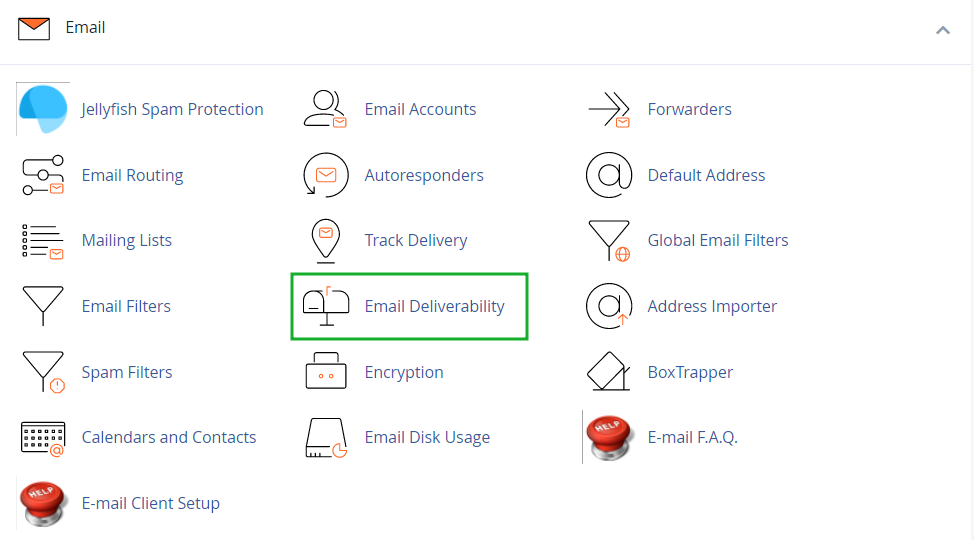






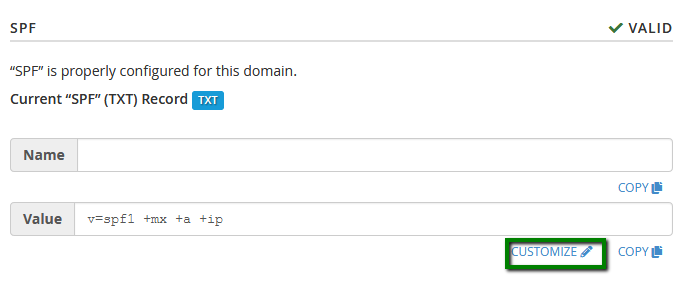
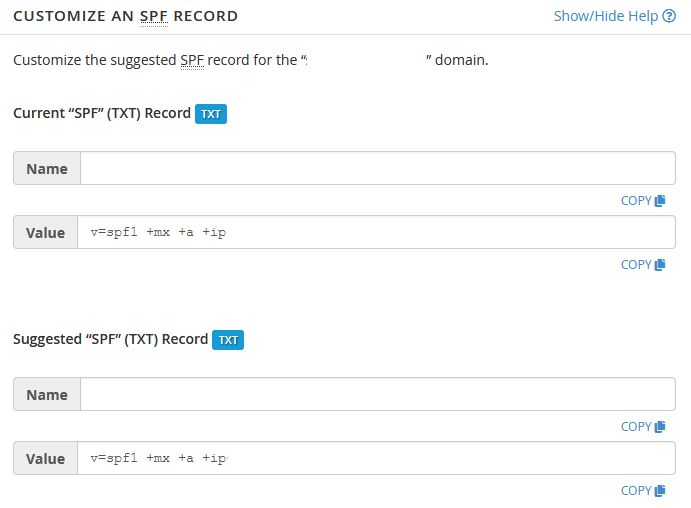
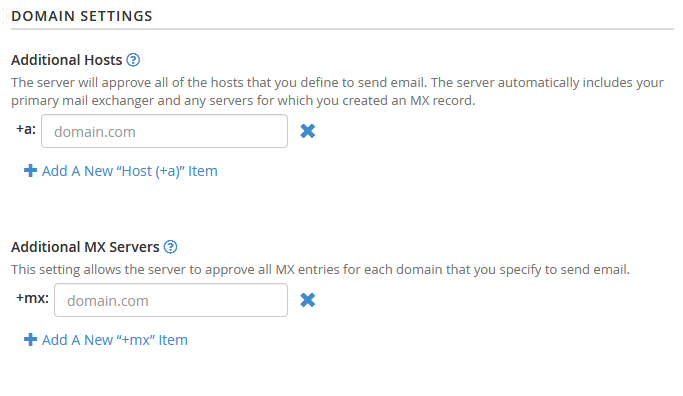
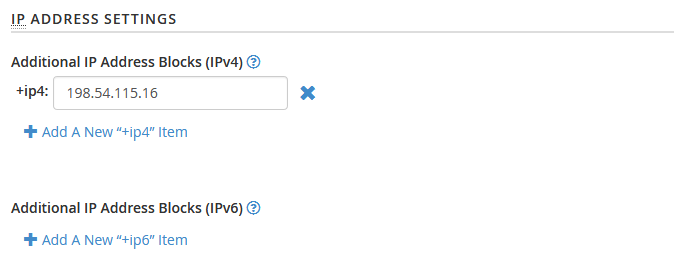
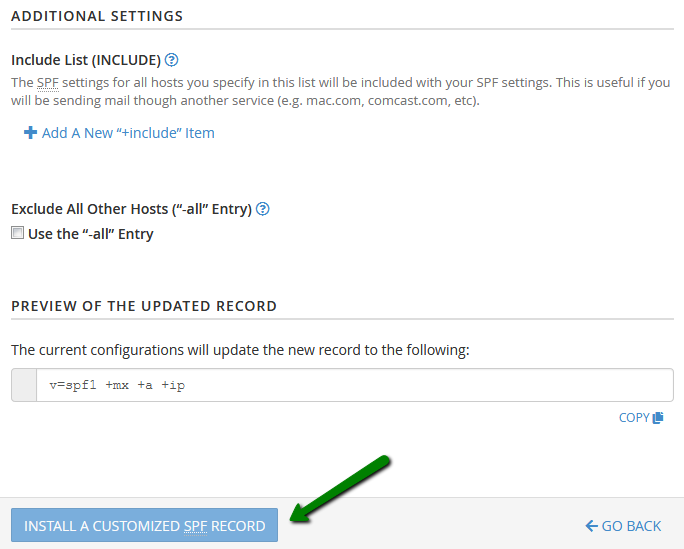
_dmarc.example.com TXTv=DMARC1;p=none;| Tag | Parameter | Description |
| v=DMARC1 | Version | Specifies the DMARC protocol version. It must always be DMARC1. |
| p=none | Policy for the domain | Instructs receiving mail servers to take no action (i.e., only monitor and report) when a message fails DMARC checks. p=quarantine - moves to spam/junk p=reject - blocks the email. |
{}Need help? We're always here for you.
{}